 16/08/2009 20:31 16/08/2009 20:31 |
|
| | | OFFLINE | | Post: 18.197
Post: 855 | Registrato il: 28/08/2005
Registrato il: 20/01/2009 | Administratore | Utente Senior | |
|


Posted 7/24/09 in the BENEDICT thread:
Benedict XVI in the footsteps
of St. Anselm, the rational saint
by Paolo Rodari

July 24, 2009
AOSTA - The Pope comes to the city today. To celebrate Vespers. But it won't be a small matter.
Benedict XVI's visit today is, in fact, a true and proper homage - complete with homily - to a model of holiness, St. Anselm of Aosta and of Canterbury, who fascinates the Pope, holiness wedded to intelligence. A Christian life characterized by the ability to read to the heart of things, to the heart of facts, to the heart of reality.
Even at the cost of being out of tune with others. A way of life that mirrors very much Papa Ratzinger's own temperament.
The homage to St. Anselm (1033-1109), a Benedictine philosopher who became Archbishop of Canterbury and Doctor of the Church ('Doctor Magnificus'), comes on the 900th anniversary of his death.
The Cathedral of Aosta, which dates back to the 4th century, is dedicated to Mary of the Assumption, but it was also Anselm's seat when he was Bishop of Aosta.
Benedict XVI will be seeing the new cenotaph 'Tribute to St. Anselm', by the British sculptor Stephen Cox, which has been installed at the south entry to the Church.
The cathedral itself is the site for many of the activities programmed by the Diocese and the region for the Anno Anselmiano, which began last April.
Last April, on the actual anniversary of Anselm's death, the Pope wrote a letter to Dom Notker Wolf, the Primate Abbot of the Benedictine Confederation, in which he called Anselm 'a true European saint'.
He said that "the memory left behind by Anselm is to be meditated with devotion and the treasure of his wisdom to be exalted and explored".
The Anselmian model is similar to many other figures that Benedict XVI likes to cite. Among them, the English Cardinal John Henry Newman, a convert from Anglicanism, who will be beatified this year. Newman's life was characterized like Anselm's by the union of faith and intelligence, faith and reason.
Who was Anselm? What is his legacy? Which ideas of Anselm does Joseph Ratzinger closes to his own spirituality?
Anselm was, above all, a monk. Although he became an archbishop, he wished to remain a Benedictine monk, always strongly conscious of the importance of the monastic life.
It is well known that if Joseph Raztinger had not become Pope, he would have retired to a 'monastic' life of prayer, study and deepening his understanding of the mysteries of the faith.
"Nostalgia for the monastery," Papa Ratzinger wrote Dom Wolf, "accompanied him the rest of his life. He said so when, with great sorrow to him and his monks, he had to leave the abbey to undertake the episcopal ministry, for which he did not feel himself suitable".
There is a cardinal occupation in Anselm's life that is very much shared by Papa Ratzinger: the lectio divina - reading Scripture "not in tumult but in quiet, not in haste, but in calm, with attentive and loving meditation."
"In his writings about the mysteries of the faith, there is no separation between erudition and devotion, between mysticism and theology", he further wrote.
Anselm's example continues to be very relevant. Underlying most of the Ratzingerian texts is that Anselmian love for the truth of the faith and for deepening an understanding of it through reason. Indeed, the Pope notes, "faith and reason - fides et ratio - are found wonderfully united in Anselm".
This is a battle Joseph Ratzinger has always carried forward - unting faith and reason, two forms of cognition which are often considered incompatible and alternative.
"As though", the Pope wrote to Cardinal Giacomo Biffi, who represented him at the anniversary Mass for Anselm last April, "he who uses reason does not need to believe, and he who believes must perforce do so outside the field of rationality".
"St. Anselm," Biffi said in his homily at that Mass, "would shudder at such an attitude. For him, and for every Christian who is adequately informed, faith is not only inseparable from reason, but it is, in fact, the supreme and highest exercise of our intellectual faculties."
[And I shiver every time the Holy Father cites Augustine and Anselm and other Fathers and Doctors of the Church who obviously are very much like who he is, and I must then restrain myself, almost superstitiously, from projecting into the future....]
The Pope and the Valdostans
by Mario Ponzi
Translated from
the 7/24/09 issue of

Messages sent by hand to whoever might have the good fortune to get near the vacation residence. Knick-knacks and various objects of local artisanship sent as a homage to the illustrious guest. Home-made sweets and traditional cakes to express the sense of family with which they experience his geographical closeness.
In this way, the Valdostans have managed to show their respectful affection for Benedict XVI.
Now, they are preparing to experience his presence in a more concrete manner when he comes to Aosta, the capital, this afternoon to celebrate Vespers at their Cathedral.
Of course, some of them have already had occasion to meet him. Last of all were the three mothers and their children who are his neighbors in Les Combes.
But the Valdostans have had the experience of having the Pope among them in summer for two decades by now. [John Paul II spent summers in Les Combes ten times since 1989.]
We spoke to Don Aldo Armellin, the priest who is the diocesan liaison with the papal residence in Les Combes.
How has the community experienced the presence of the Pope so far?
I would say, as a moment of grace. It's the thirteenth time that a Pope has come to Val D'Aosta for a vacation. John Paul II loved our mountains. And now, it's the third time for Papa Ratzinger.
It's the renewal of what we would like to call by now a beautiful custom . But the presence of the Pontiff among us is always an event capable of arousing deep emotion.
Before the Pope arrived, the order given was 'to guarantee him privacy and absolute rest'. But it seems that the chances for encountering the Pope do come up even if in some cases, these are unexpected. But how are you preparing for the encounter at Vespers on Friday?
Actually, the diocese now has two big events on the program. The first is Vespers. The bishop had asked the Pope if he could meet with the clergy and the religious of the diocese [as he did during his two previous vacations here]. Benedict XVI expressed the wish that the invitation could be extended as well to representatives of the entire ecclesial community, and so we will have more than 400 persons at Vespers, many of them lay people.
But we are sure that many more will come to the Cathedral Square, and the Pope will greet them after Vespers. And even more will be lining the route that the Pope will take to get to teh Cathedral.
The second event is the noontime Angelus on Sunday, July 26, at which we expect to have a very good attendance. Above all, there will be Valdostans themselves, but certainly there will be many of the
tourists who are on vacation themselves in this area.
As the liaison to the Pope's vacation residence, you are, in effect a link between him and the community. What has been your experience so far?
That we have always been guided by respect for the Holy Father's needs. He is here for a vacation and the Valdostans are with him in prayer, respectful of his privacy but also seeing every encounter as a gift. And these have always been far richer than one expects.
Have there been any special messages or gifts entrusted to you for conveying to the Pope?
Yes. There are so many who want to reach out to the Pope even if only by sending him a message of good wishes, or to show him their affection and gratitude with a simple gift, to show him their feeling of family by sending him a home-made dessert.
Usually, the written messages come from sick and suffering people, those who are in particular difficulties. There are so many of them. So Friday night, after Vespers, he will be visiting the home for the aged in Introd in representation of all these persons in need.
Do you think that the religiosity of the Valdostans comes from popular tradition or from genuine faith that they live in their daily lives?
Ours is a deep faith that is expressed in our traditions. Of course, we too have been affected by secularization and so, some religious certainties of tradition are being questioned.
So I think that, as for the universal Church, so too the Church in Val D'Aosta is challenged to make our people encounter the beauty of Christian life and the evangelical announcement in the rhythms of our daily life, which presents so many opportunities.
Would you describe the Valdostan community as youthful for its vivacity, adult for its mature faith, or aging by the inertia of its habits?
You cannot define the community that easily. In some sectors, there is definitely a great liveliness - in the oratories, the volunteers for Caritas, the catechists and other pastoral workers. At the same time, there are, of course, elements of Christian life that are lived as routine - but that's how it is in every diocese or Christian community.
The Bishop of Aosta says
'the Pope confirms us
in our faith'
Translated from

July 22, 2009
"The presence of the Pope in the Cathedral makes visible the primary responsibility of the unviersal Church in the world and is a call to reawaken faith, hope and love", Mons. Giuseppe Anfossi, Bishop of Aosta, says in the diocesan weekly Corriere della Valle, as he looks forward happily to the two big diocesan events during the Pope's vacation.
Speaking about the Vespers in Aosta Cathedral Friday afternoon, Anfossi points out that "a cathedral is a place rich with symbolic significance. First of all, its the bishop's seat. When all the priests of the diocese are under one roof, it is a visible sign of communion with their bishop, and tomorrow, of our communion with the Bishop of Rome as well".
Mons. Anfossi adds:
"There's even more significance this time. Benedict XVI recently launched the Year for Priests. So with this encounter, he will also be calling on the faithful to rediscover the beauty of the priestly ministry, on the priests to be fully conscious of their own ministry and responsiblity, and of the relationship that their ministry has to other services, charisms and ministries in the Church.
"The presence of the Pope highlights that the first task of the bishop, of priests and of active Christians is to awaken and keep the faith alive.
"For the bishop, the most important thing to underscore is faith, because the religious and pastoral crisis experienced in today's society is fundamentally a crisis of faith."
Mons. Anfossi adds: "We are very happy that the Pope himself made known what he wants to do while he is on vacation among us, and even if he cannot use his hand to write, we hope that the very place itself is a continuing source of inspiration."
"Praying with him as the Successor of Peter, we feel confirmed in the faith, sustained in our hope, and fully engaged in charity."
[Modificato da TERESA BENEDETTA 16/08/2009 22:58] |
| |
|
| |
 16/08/2009 20:33 16/08/2009 20:33 |
|
| | | OFFLINE | | Post: 18.198
Post: 856 | Registrato il: 28/08/2005
Registrato il: 20/01/2009 | Administratore | Utente Senior | |
|


Posted 7/24/09 in the BENEDICT thread:
AN IMPROMPTU PASTORAL VISIT
The setting: The city and diocese of Aosta, with its newly-restored Cathedral of the Assumption.
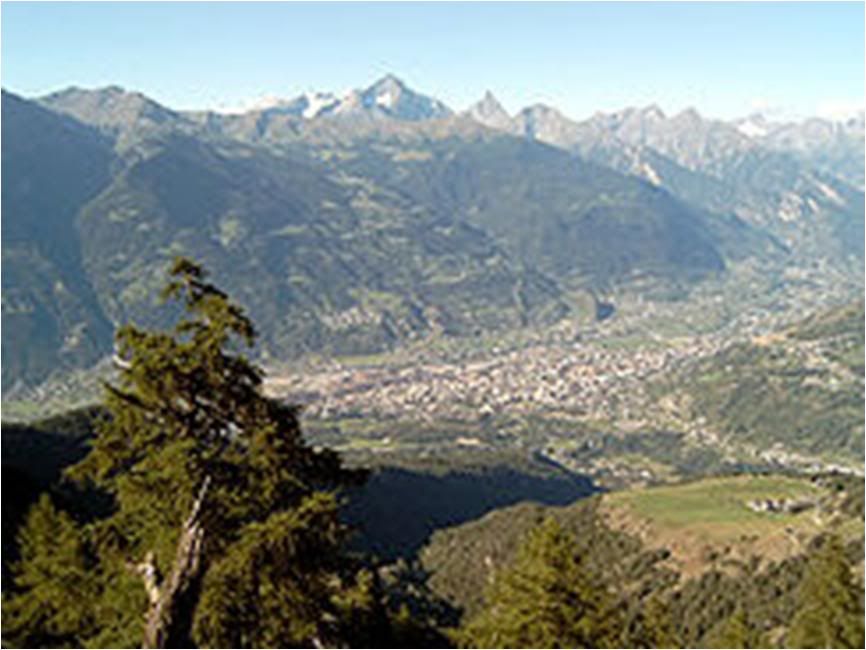 Aosta, 110 kms north-northwest of Turin, is the capital of Val D'Aosta region, and is located near the entrance to the Mont Blanc tunnel through the Alps, and near the junction of the Great St. Bernard and Little St. Bernard passes.
Aosta, 110 kms north-northwest of Turin, is the capital of Val D'Aosta region, and is located near the entrance to the Mont Blanc tunnel through the Alps, and near the junction of the Great St. Bernard and Little St. Bernard passes.
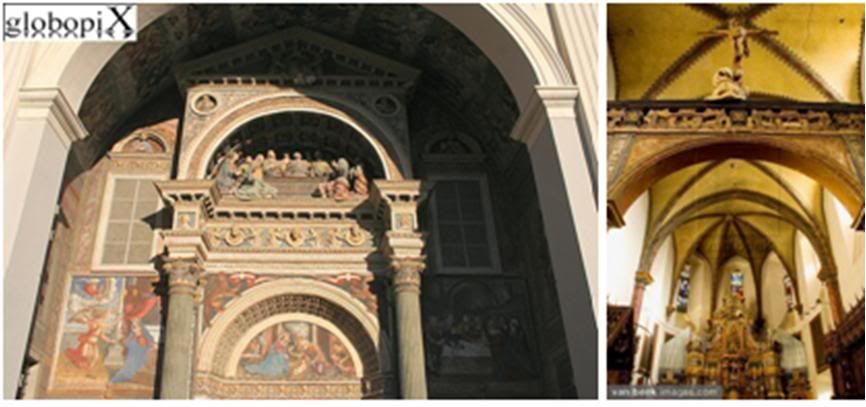 Aosta, named for the Emperor Augustus, dates back to the Augusta Praetorium Salassorum colony established by the Romans in 25 BC. The Augustan Arch, below left, is one of the entrances to the city.
Aosta, named for the Emperor Augustus, dates back to the Augusta Praetorium Salassorum colony established by the Romans in 25 BC. The Augustan Arch, below left, is one of the entrances to the city.
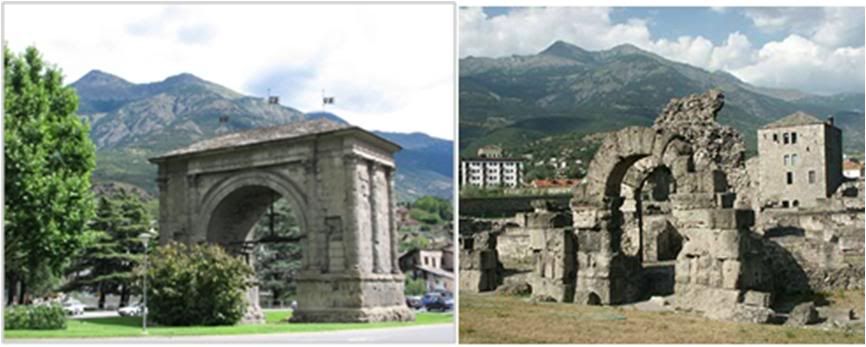
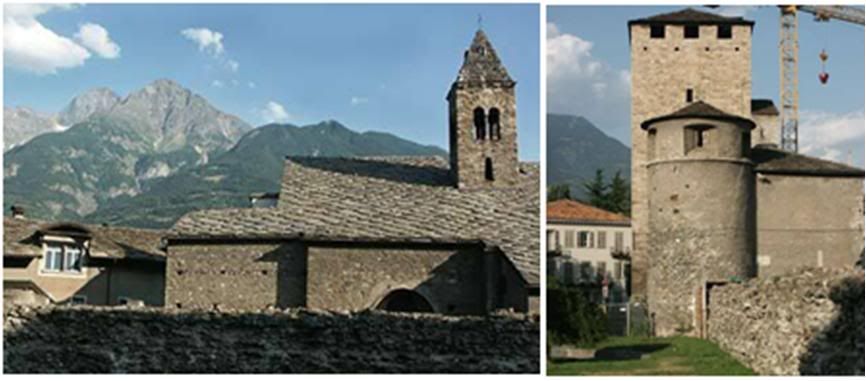
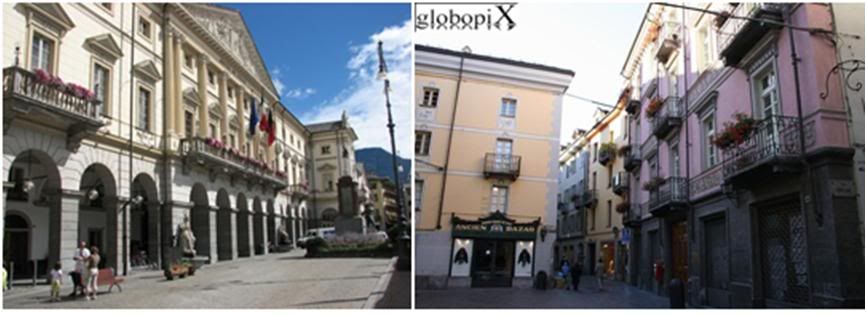
The Pope rode through the center of Aosta from the Augustan Arch to the Cathedral in an improvised Popemobile.
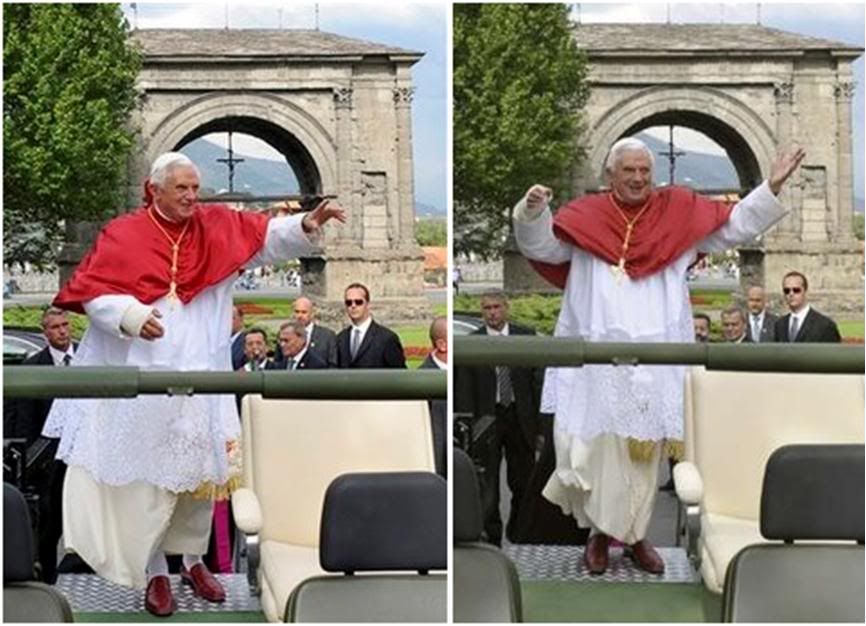

Below, passing through the main square in front of City Hall.
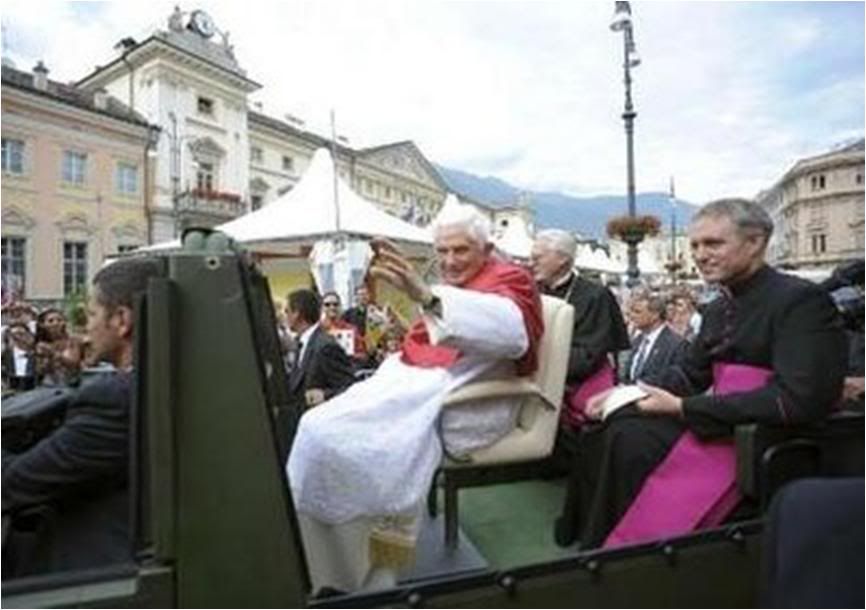
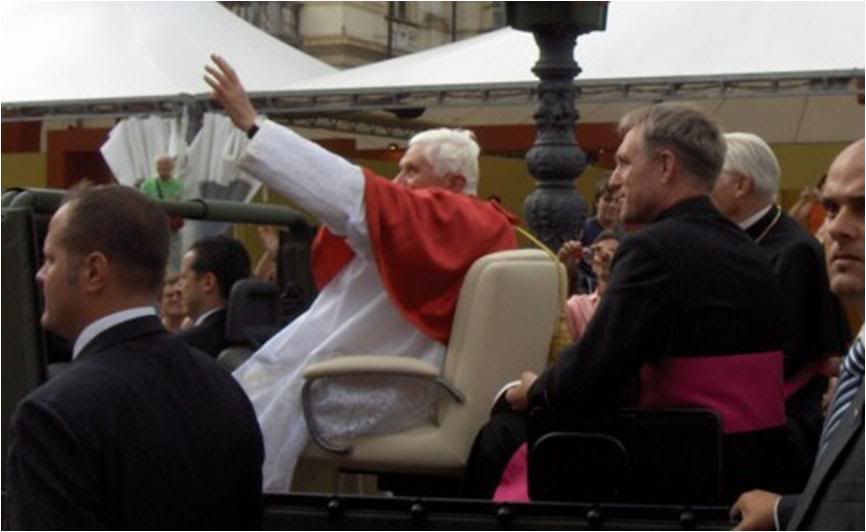

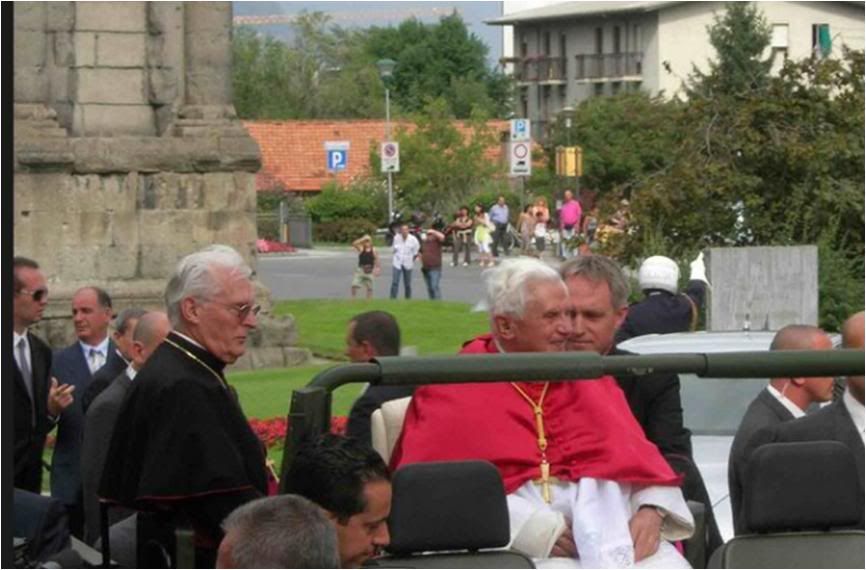
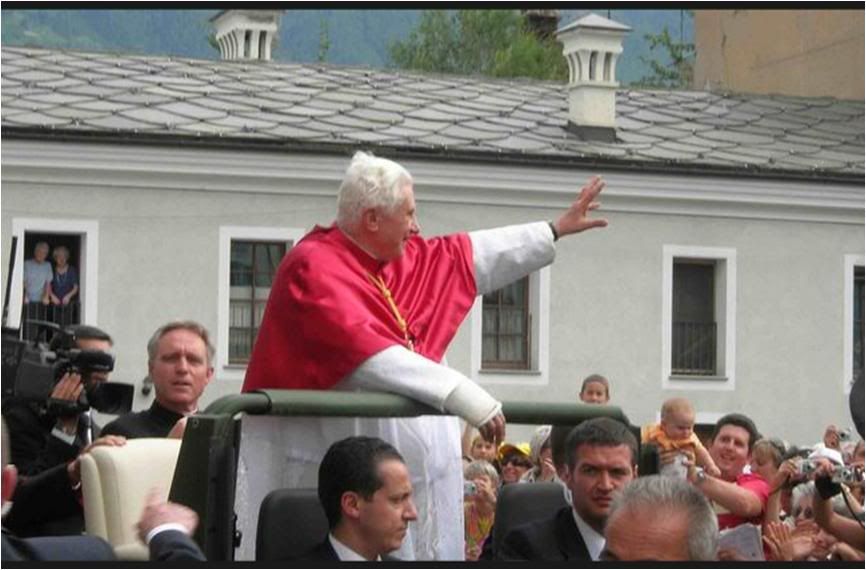
At the Cathedral, the improvised 'Popemobile' went around the Church and through the crowd gathered in the square before the Pope got off.
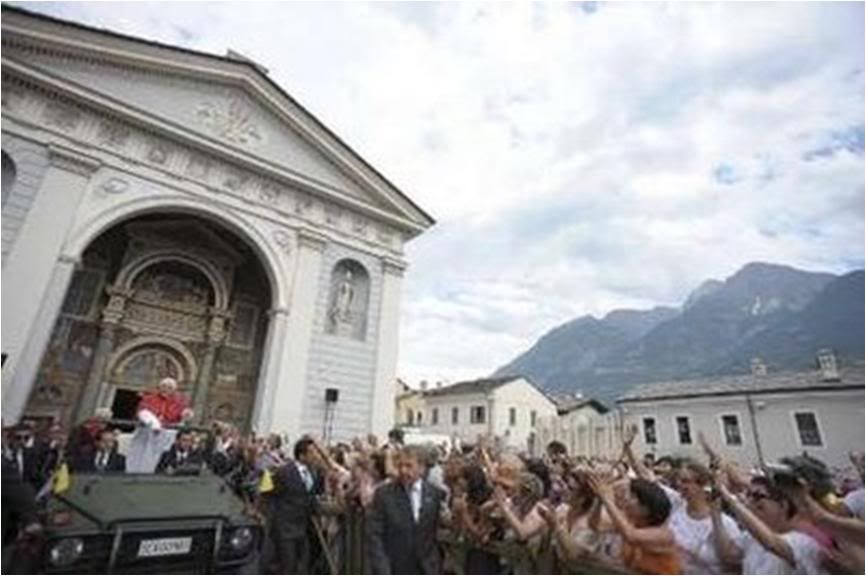
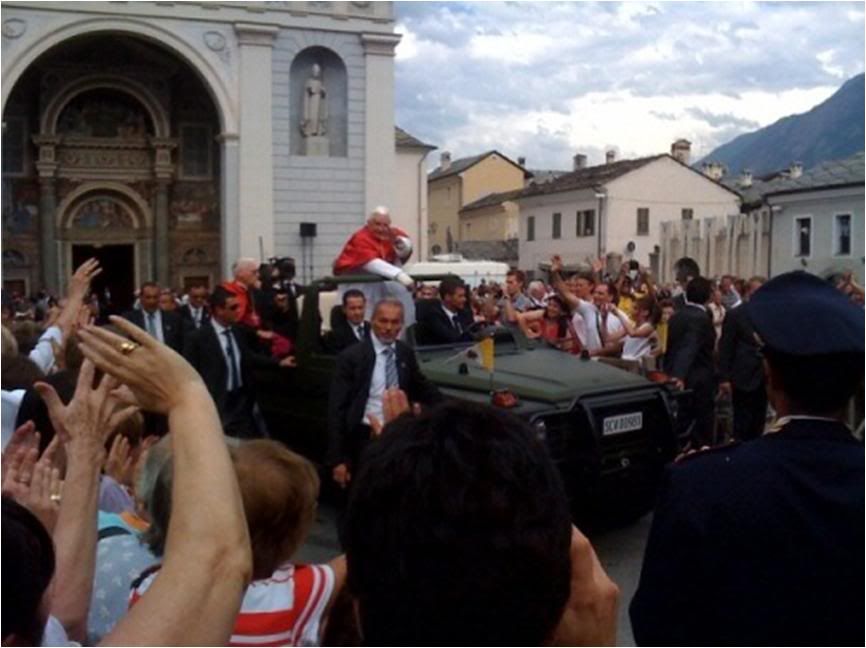


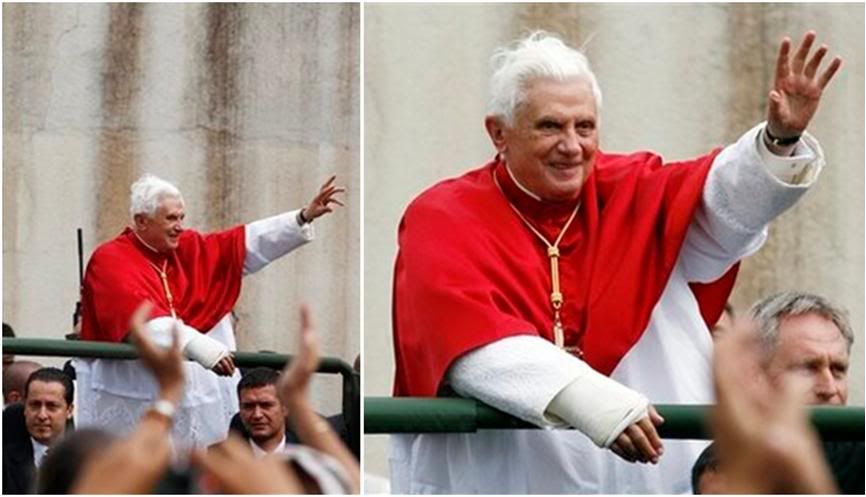
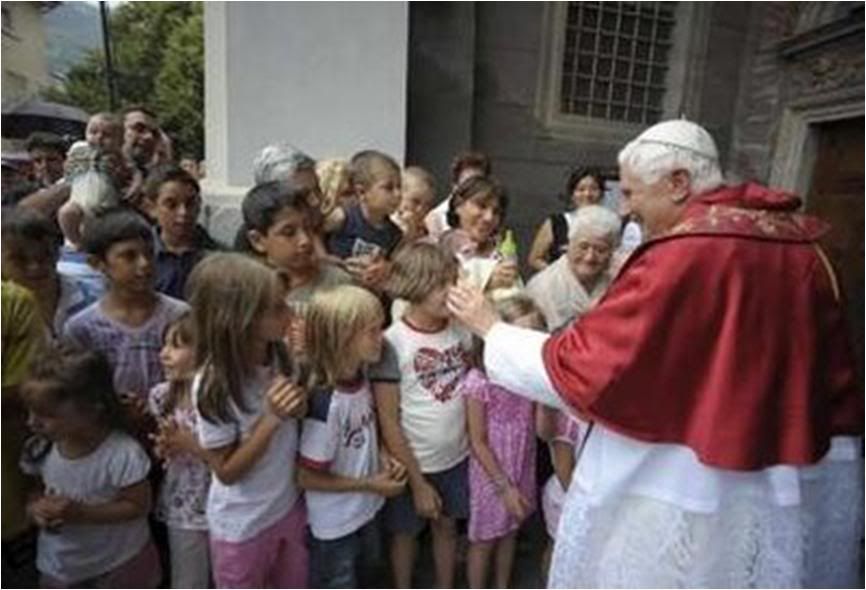
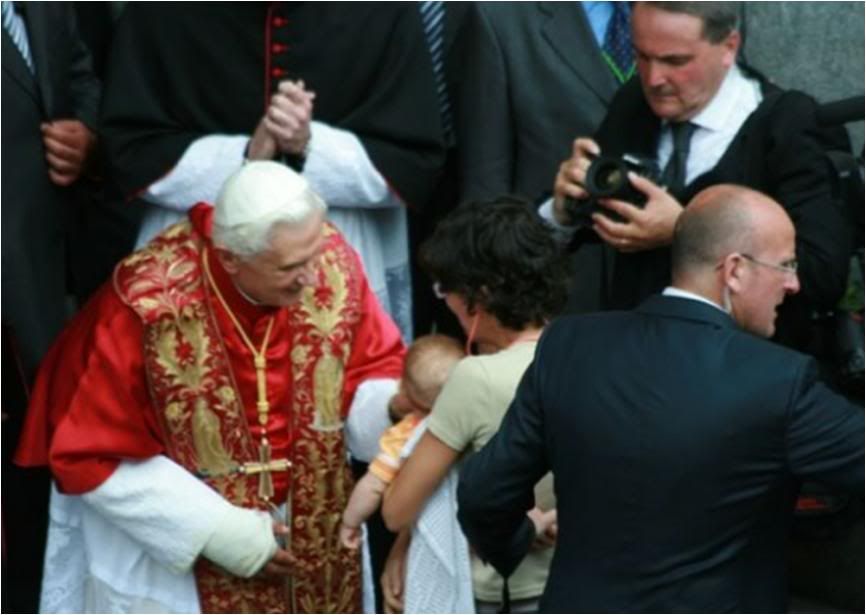
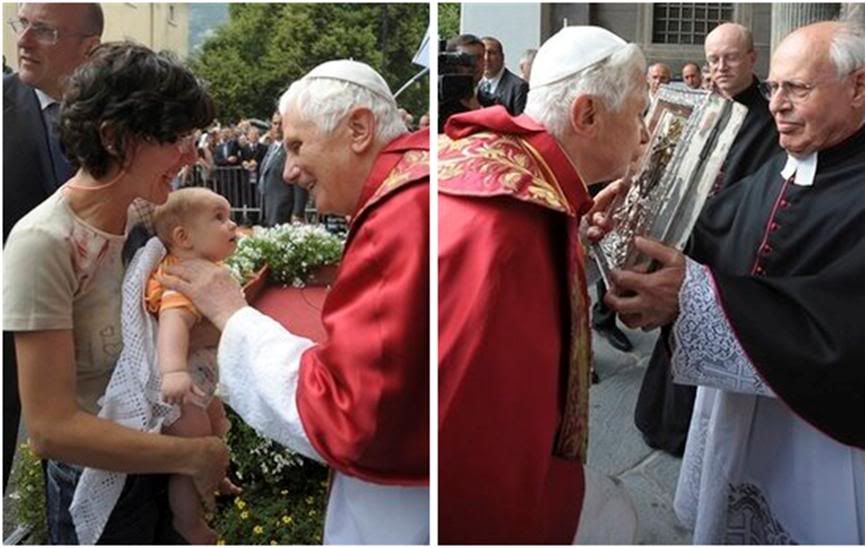
Inside the Cathedral.
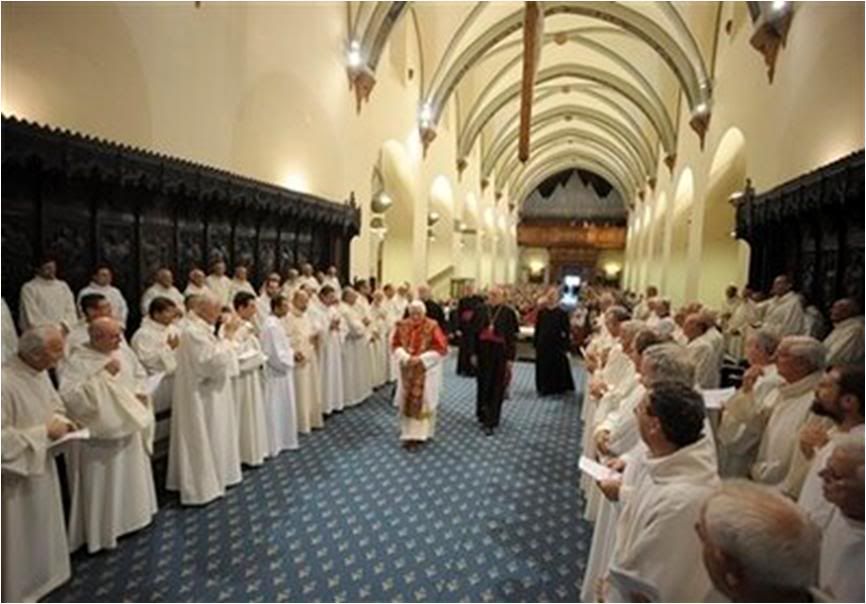
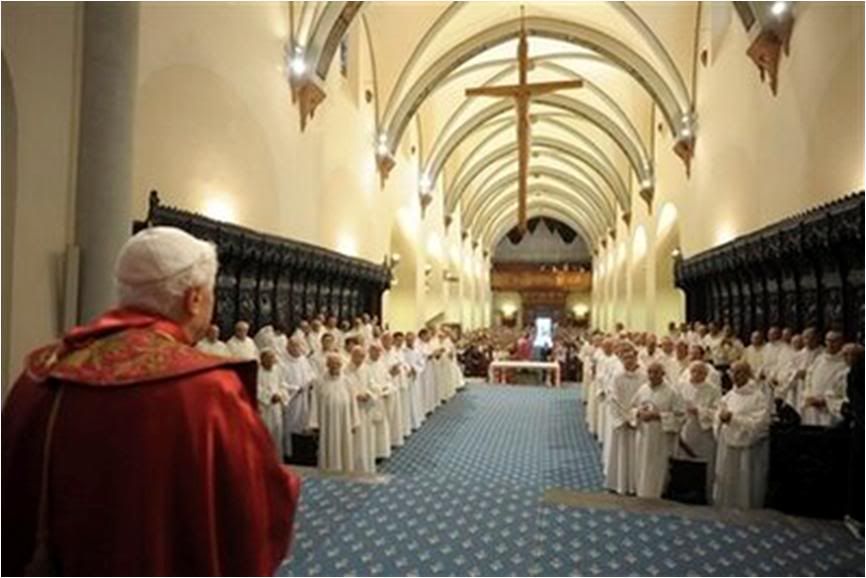
Greeting the faithful after Vespers.
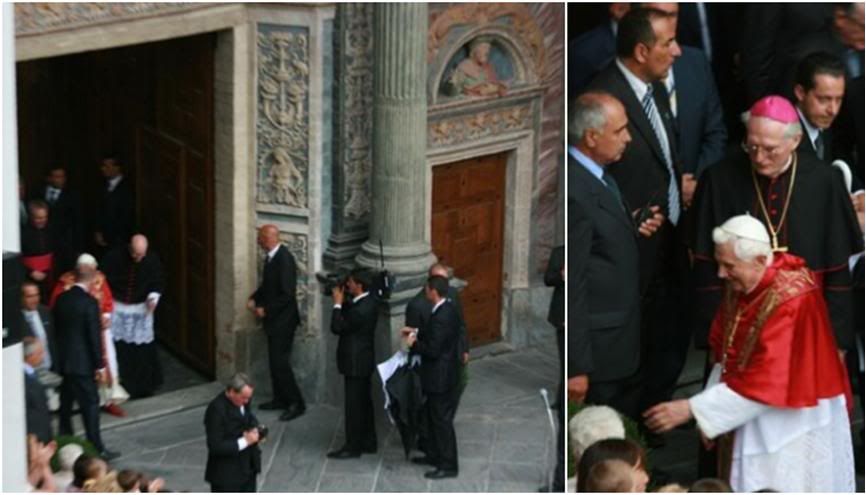
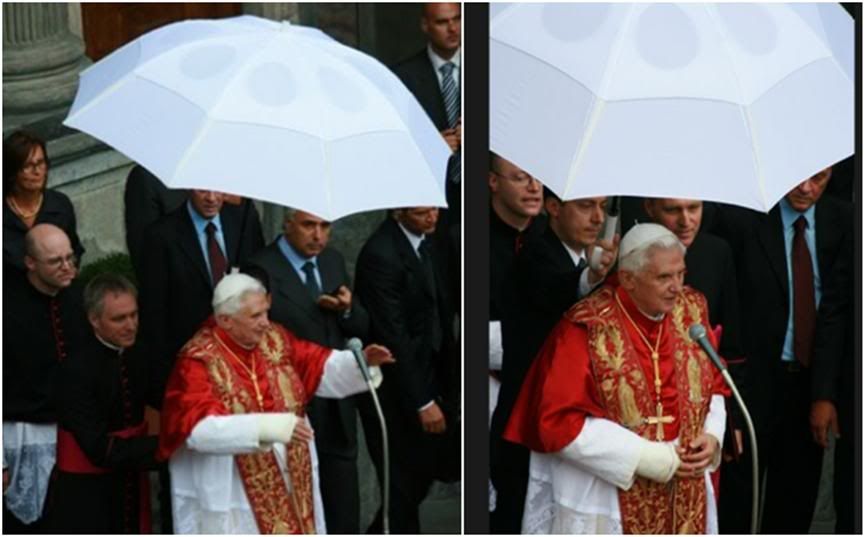
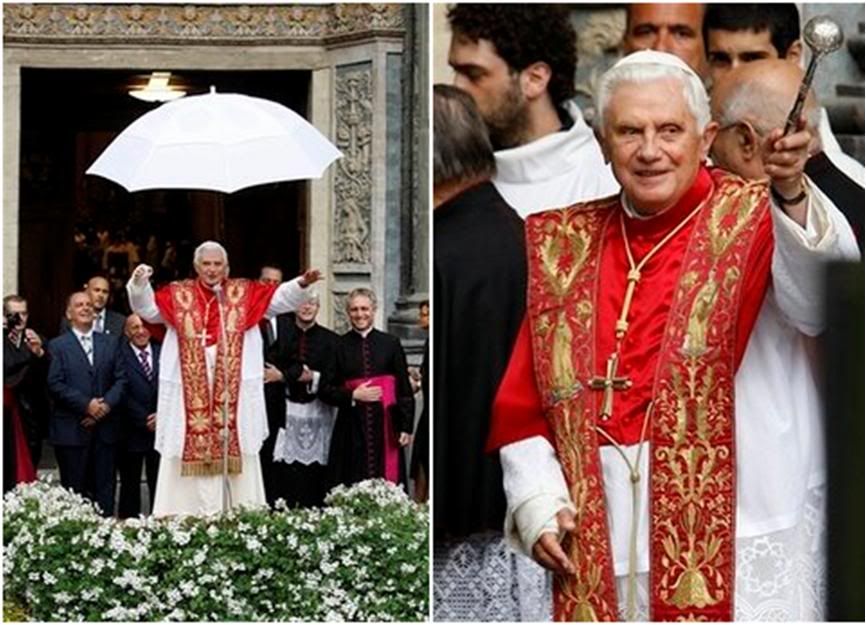
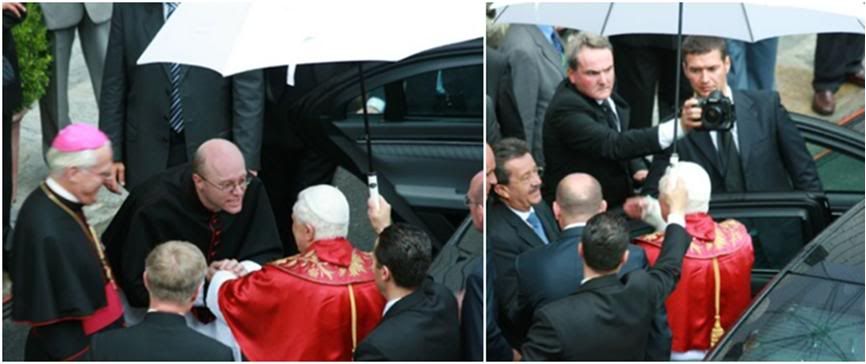 The only wrap-up story of sorts that I have seen so far is this one from a local Aosta online paper, and it is sketchy
The only wrap-up story of sorts that I have seen so far is this one from a local Aosta online paper, and it is sketchy.
The Pope wishes everyone
a good vacation -
without an accident
di Domenico Albiero

July 24, 2009
"Thank you for your welcome, for the affection and the sympathy, Let us hope for good weather during the vacation period, as I too am on vacation," adding, "And without any accident, unlike what happened to me!"
The Pope said farewell to the Aostans this evening after celebrating Vespers at the Cathedral of Aosta. Not realizing that outside, the first few drops of rain were coming down.
It was an occasion to meet the Catholic community of Val D'Aosta and the the thousands of tourists and curious onlookers who waited for him along the route that separates the Augustan Arch from Piazza Giovanni XXIII.
People had started to gather in the city center in the early afternoon
in the hope of seeing the Pope when he arrived for Vespers with the diocesan clergy and parish representatives from all over Val D'Aosta.
Welcomed at the Augustan Arch by civilian authorities and the Bishop of Aosta, Mons. Giuseppe Anfossi, when he arrived by car from les Combes, the Pope reached the Cathedral around 5:15 p.m. after a motorcade through the city center.
He was escorted into the cathedral by the canons of the cathedral chapter.
In his extemporaneous homily, the Pope spoke of a God who was not remote but comes close to man in his suffering.
"A society without God is a society without a compass", he said, "unable to find an orientation to face, for instance, the present economic crisis, but also suffering and tragedy."
Before the Vespers, there was an exchange of gifts. The Pope gave Mons. Anfossi a chalice to commemorate the occasion, and the bishop gave him a set of liturgical vestments.
Vespers closed with the most traditional hymn of the Church in Val D'Aosta, the hymn to Mary as "O Reine immaculee'. (Like much of northwestern Italy near the Alps, Aosta is bilingual in Italian and French.)
Before going back to his vacation home in Les Combes, the Pope was scheduled to visit the home for the aged in Introd, the municipal commune to which Les Combes belongs.

has a brief item that points out something I would otherwise not have noticed.
The Pope was not wearing
the Fisherman's ring today
And Fr. Lombardi explained that for the past few days, the Holy Father has not been wearing the ring 'to simplify things', since his right forearm and hand are in a cast and in a sling, and especially since he has no public events.
[But the Vespers in Aosta was public. Obviously, neither GG nor Paolo the valet, who was riding in the front passenger seat of the Pope's jeep today, noticed nor reminded him.... It doesn't matter: we know he's the Pope!]
BTW, it just occurred to me, looking at the pictures tonight, that providing security for the Pope has got to be the most challenging security task on earth. No President of the United States - after JFK was shot in Dallas - ever has to ride an open car as the Pope does, or address audiences in open air regularly at a known place and time as the Pope does for his Wednesday audiences and any of his other scheduled public events. In short, no one is as vulnerable because no one is as exposed.
We must trust that Inspector Giani and his Italian counterparts are in 'continuing education' with the top minds of the US Secret Service and the Israeli Mossad on the state of the art of assuring the safety and minimizing the risk to their super-precious charge!
[Modificato da TERESA BENEDETTA 16/08/2009 22:58] |
| |
 16/08/2009 20:35 16/08/2009 20:35 |
|
| | | OFFLINE | | Post: 18.199
Post: 857 | Registrato il: 28/08/2005
Registrato il: 20/01/2009 | Administratore | Utente Senior | |
|


Posted 7/25/09 in the BENEDICT thread:
Here is a translation of Vatican Radio's transcription of the homily delivered extemporaneously Friday evening by the Holy Father during Vespers at the Cathedral of Aosta.

 THE HOLY FATHER'S HOMILY
THE HOLY FATHER'S HOMILY
AT VESPERS IN AOSTA
Excellency,
Dear brothers and sisters,
I wish first of all to say 'Thank you", Your Excellency, for the words with which you have introduced me to the great history of this cathedral. You have made me feel that we pray here, not only at this moment, but that I pray with [the faithful of] past centuries in this beautiful church.
And thanks to all of you who have come to pray with me and to make visible this network of prayer that links us all and always.
In this brief homily I wish to say a few words about the prayer with which these Vespers conclude, because I think that in this passage from the Letter of the Romans, prayer is interpreted and transformed.
The prayer in Romans has two parts: an addresss - a heading, we might say - and then, the prayer itself made up of two requests.
Let us start with the address which itself has two parts: it concretizes the 'you' with whom we talk in prayer, so we can better knock at the door of God's heart.
In the Italian text, we read simply: "Merciful Father". The Latin text is more ample - "Almighty and merciful God".
In my recent encyclical, I have tried to show the priority of God both in our personal life, as well as in the life of history, of society, of the world.
Certainly, choosing God is something profoundly personal, and the person is a being in relationships. If the fundamental relationship - the relation with God - is not there, if it is not lived, then all of man's other relationships cannot find their correct form. And this goes likewise for society, for mankind as such.
If God is missing, if one does without God, if God is absent, then there is no compass to show the entirety of all relationships that can make us find the way, the orientation in which one must proceed.
God: we must bring back to the world the reality of God, make him known, and make him present. But how are we to know God? In the ad-limina visits, when I speak with the bishops where traditional relgions still exist - above all in Africa, but also in Asia and Latain America - these religions have many details that are diverse from one another, of course, but they also have common elements.
All know that there is a God, one God, that God is a word in the singular, that the gods are not God, that there is God, the God.
But at the same time, this God seems absent, very distant, who does not seem to come into our daily life - he is hidden, we do not know his face. And so religions concern themselves mostly with things, powers that are nearer, spirits, ancestors, etc. - since God himself is too distant, one must deal instead with these powers closer to hand.
The act of evangelization consists precisely in the fact that it brings closer that 'distant' God. God is no longer distant but close, so that this 'known unknown' can now make himself known, he reveals himself, the veil over him disappears, and he shows his face.
And because God is near, we can know him, he shows us his face, he enters into our daily life. We no longer have to deal with other 'powers' because he is the true power. He is the Almighty.
I do not know why they omitted the word 'almighty' (omnipotent) in the Italian text. The truth is we all feel somewhat threatened by omnipotence - it would seem to limit our freedom, it seems a bit too strong. But we should learn that the omnipotence of God is not arbitrary power, because God is Goodness, he is the Truth. God can do everything but be cannot act against what is good, he cannot act against the truth, he cannot act against love and against freedom, because he himself is goodness, he is Love, he is true freedom. So, everything that he does can never be against truth, love and freedom. On the contrary.
He, God, is the custodian of our freedom, of love and of truth. The eye that sees us is not an evil eye that keeps us under surveillance - it is the presence of a love which will never abandon us and which gives us the certainty that it is good that we exist, it is good to live. He is the eye of love who gives us the space to live.
'Almighty and merciful God'. This text from the Letter to the Romans, is linked with a passage from the Book of Wisdom, which says: "You, God, show us your omnipotence in forgiveness and mercy." The peak of God's power is mercy, it is forgiveness.
In the world concept today of power, we think of someone with large properties, who has something to say about the economy because he can dispose of capital to influence the world through the market.
Or we think of someone who has military might, who can threaten. Stalin's question, "How many divisions has the Pope?", still characterizes the average idea of power.
And ther is power that can be dangerous, that can threaten, that ca ndestroy, that holds so many things of the world in its hands.
But Revelation tells us it is not so. True power is the power of grace, the power of mercy. In his mercy, God shows his true power. So the second part of this prayer's address says, "You have redeemed the world with the passion, with the suffering of your Son".
God suffered, through his Son, with us. This is the peak of his power that he is capable of suffering with us. That is how he shows us the true divine power - that we wished to suffer with us, and that he will never leave us alone in our suffering. God, in his Son, had suffered with us and is therefore close to us in our suffering.
Nonetheless, the difficult question remains, one that I cannot now interpret amply: why was it necessary to suffer in order to save the world? It was necessary ebcause there exists an ocean of evil in the world, an ocean of injustice, of hatred, of violence.
And all the victims of hatred and injustice have the right to justice. God could not ignore the cry of those who suffered and who had been oppressed by injustice.
To forgive is not to ignore but to transform, so God had to enter into this world to oppose this ocean of injustice, much greater than that of goodness and love.
That explains the Cross, and from that moment, against that ocean of evil, there now exists an infinite river that will always be greater than all the injustices of the world, a river of goodness, of truth and of love.
God forgives, transforming the world. He enters our world so that there can be a power against evil, in that river of goodness that is always greater than all the evil that can ever exist.
The address to God is also an address to ourselves: God invites us to place ourselves on his side, to leave that ocean of evil, of hate, of violence, of selfishness, and to identify ourselves with the river of his love, to enter into it.
And this is the request contained in the first part of the prayer: "Grant that your Church may offer itself to you as a living and holy sacrifice".
This appeal, addressed to God, also concerns us. It refers to two passages in the Letter to the Romans. In Chapter 8, Paul says: "We ourselves should become a living sacrifice".
We ourselves, with all our being, should become adoration, sacrifice. We should restore our world to God and thus transform the world.
And in Chapter 1, Paul describes the apostolate as priesthood. The function of the priesthood is to consecrate the world so that it becomes a living host, it becomes liturgy. That liturgy is not just something alongside the realities of the world, but that the world itself may become a living host, it becomes liturgy.
It is the great vision that Teilhard de Chardin later had, that in the end we would have a true cosmic liturgy, when the world becomes a living host.
Let us pray to the Lord that he may help us to be priests in this sense of helping to transform the world, in the adoration of God, and begin by transforming ourselves. So that our life may speak of God, that our life becomes liturgy, an announcement of God, the gate through whci a distant God becomes the God who is near, and that we truly give ourselves to God.
Then comes the second appeal: "Grant that your people may always experience the fullness of your love". In the Latin text it says, "Satiate us with your love". Thus, the text refers to the psalm which we sang, "Open your hand and satiate the hunger of every living being".
How much hunger there is on earth! Hunger for bread in so many parts of the world - and Your Excellency has spoken of suffering among families here - hunger for justice, hunger for love. With this prayer, we ask God, "Open your hand and truly satiate the hunger of every living being. Satiate our hunger for the truth, and for your love".
So may it be. Amen.
The Pope's words to the faithful
outside the church after Vespers
Dear friends,
I would like to say simply "Thank you' for your welcome, for your affection and sympathy. Here we are all united in prayer, and we are united in the friendship that the Lord gives us.
I wish you all good weather, and a good vacation, since I, too, am on vacation - but let it be without incident to you!
Thank you, and best wishes to all....
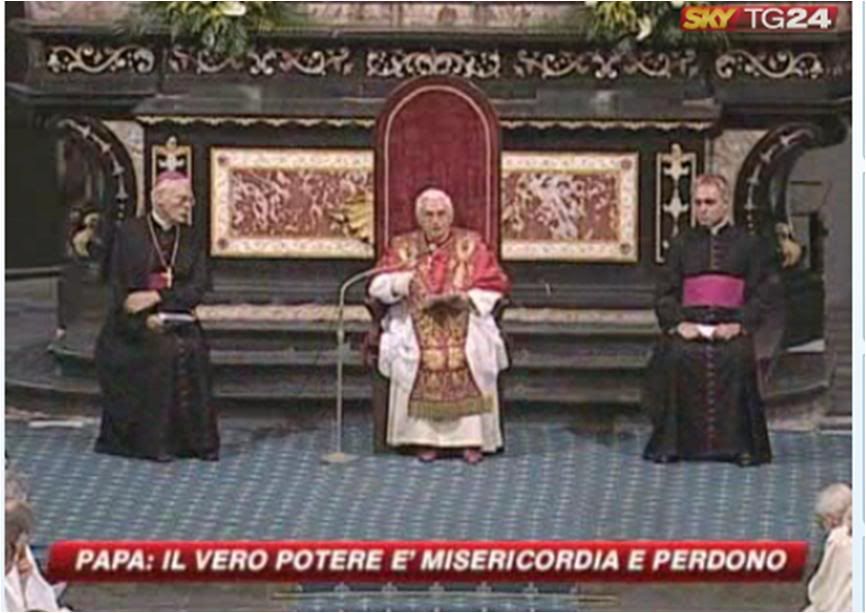

7/26/09
AOSTA VESPERS
PHOTO POST-SCRIPT
Thanks to our dear and trusted, incredibly and consistently diligent Russi - one of the earliest members of the PRF,
whose site continues to be arguably the most comprehensive, user-friendly multimedia archive on Benedict XVI -

I was able to watch the SAT-2000 coverage of the Vespers in Aosta, from which I was able to capture some pictures that give a more complete picture of an eventful although brief visit.
Better yet, I also had the singular experience once again of watching and listening to Benedict XVI extemporize a great homily with his customary flow of words, so organized and linear, with his precise vocabulary that sometimes rises to poetry - and not a single UMM... or the slightest beat of hesitation!
[And people actually think Obama is eloquent just because he has a deep baritone and can declaim with rhetorical flourish off a teleprompter! Meet the real Goldmund/Chrysostomos, Mr. O! Have you watched Obama answer a question at news conferences when he does not have the benefit of a prompter? He makes so many more UMMs and hesitations than the much-maligned Dubya who moreover had the obvious virtue of sincerity and common sense.]
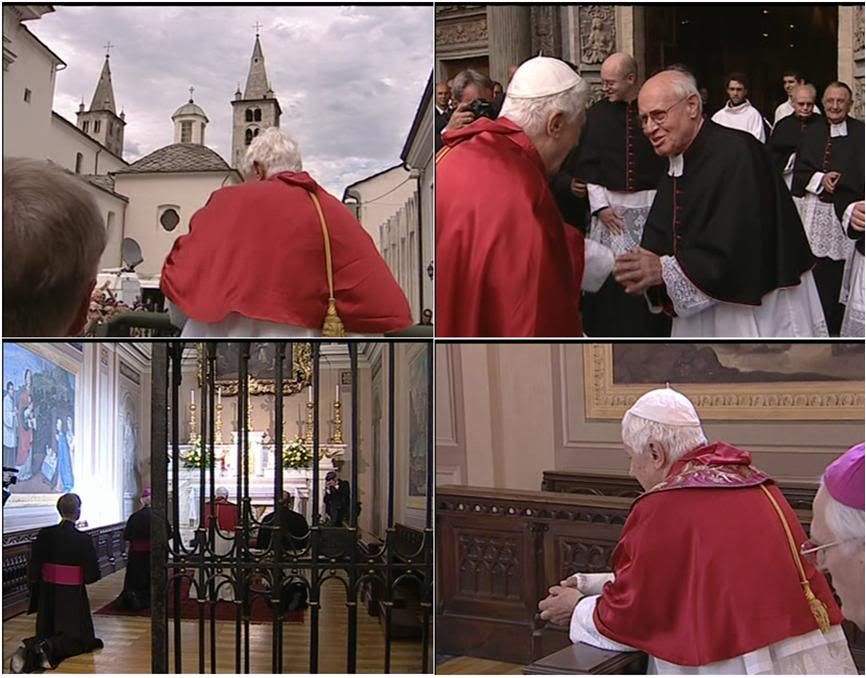
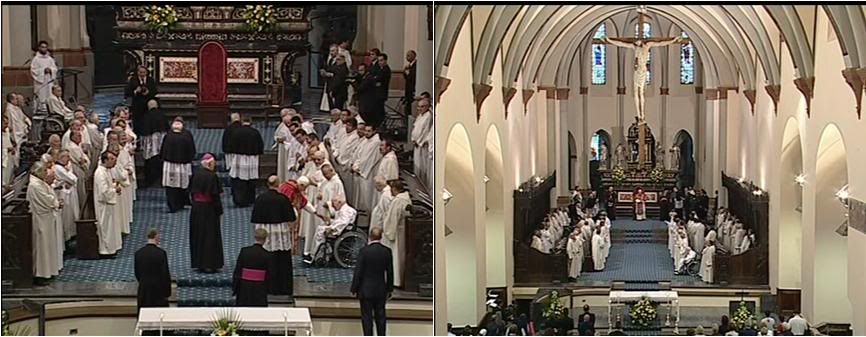
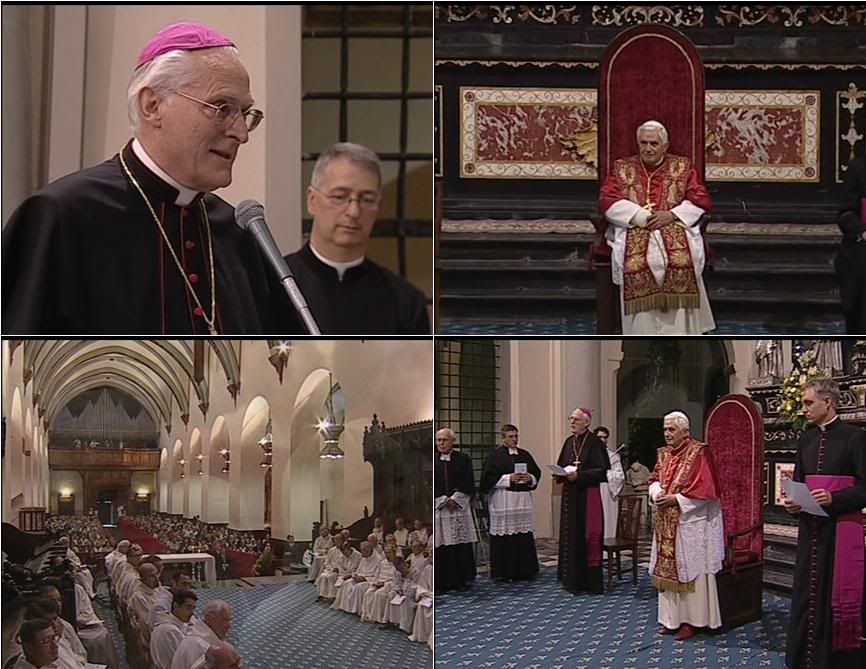


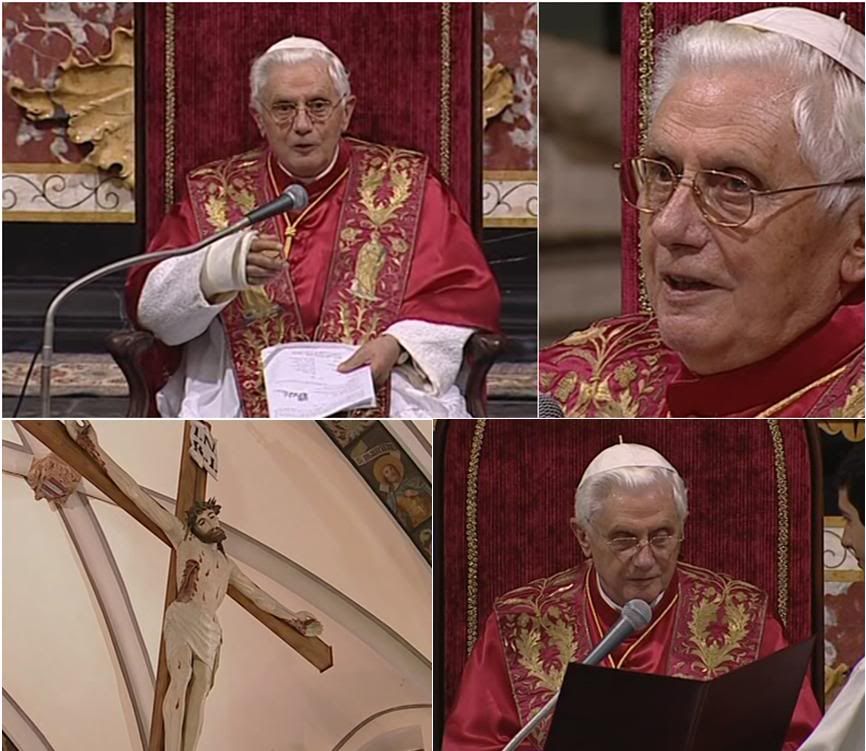
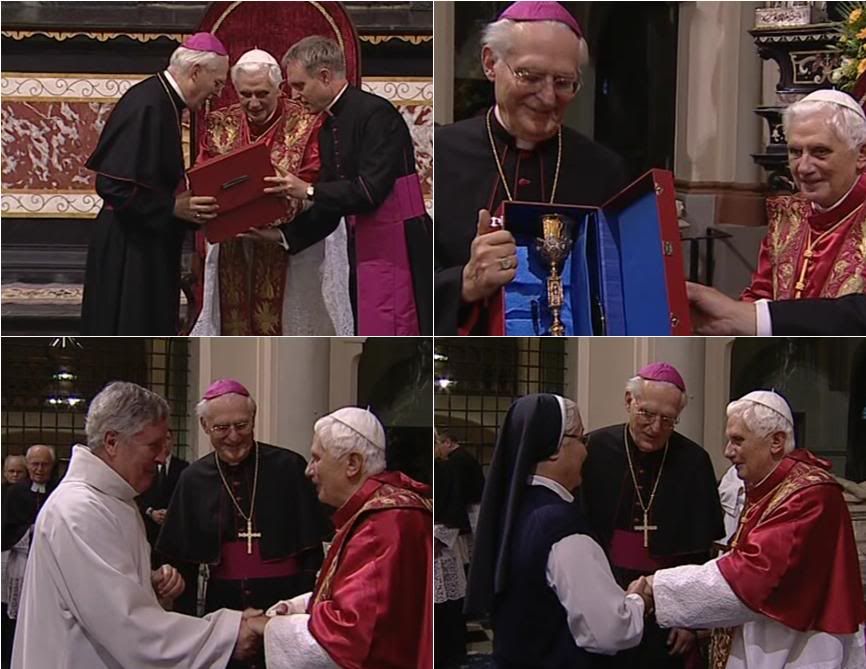
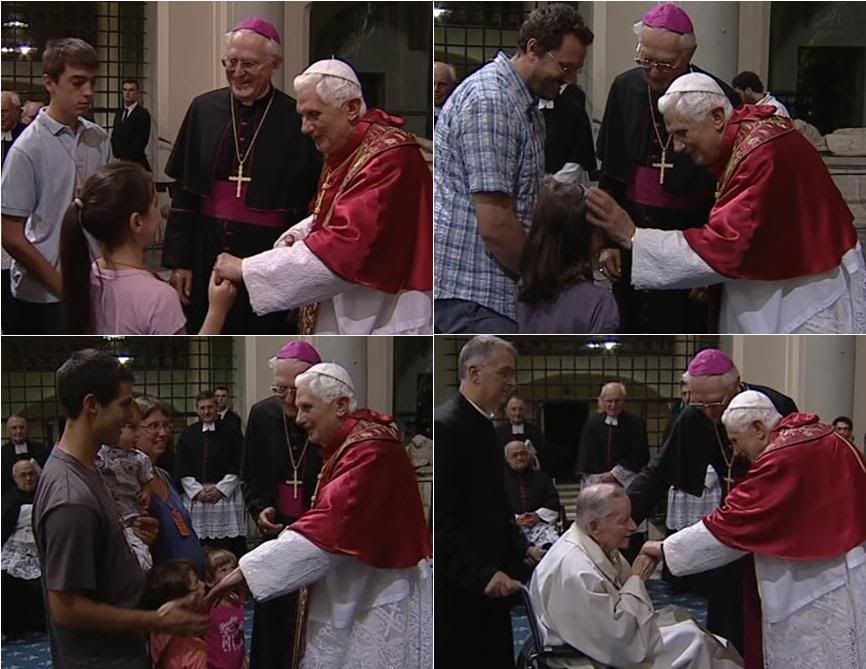
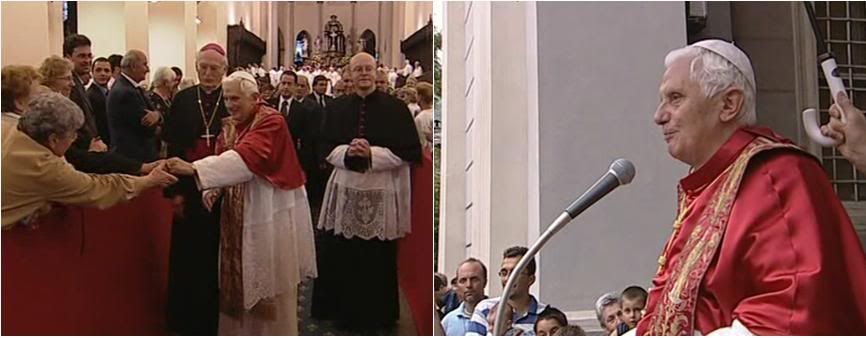
[Modificato da TERESA BENEDETTA 16/08/2009 22:57] |
| |
 16/08/2009 20:39 16/08/2009 20:39 |
|
| | | OFFLINE | | Post: 18.200
Post: 858 | Registrato il: 28/08/2005
Registrato il: 20/01/2009 | Administratore | Utente Senior | |
|


Posted 7/27/09 in the BENEDICT thread:
In a cathedral 16 centuries old,
Benedict XVI restores the message
to make God known to man
Editorial
by ANGELO SCELZO
Translated from

July 26, 2009

In the increasingly eventful chapter of 'surprises' in Benedict VXI's Pontificate, the Vespers he celebrated at the Cathedral of Aosta last Friday is a new entry from many aspects.
Think of it: the Pope is on vacation, the rhythms of normal life are generally slowed down everywhere in summer, and a carefree atmosphere attests to the fact that summer is a season of the ephemeral.
And suddenly from the cathedral that was once St. Anselm's seat in Aosta, words come forth that resonate with the 16 centuries of faith conserved within those walls - recently restored to some of its ancient splendor - but also indicating the path for a new future, as Pope Benedict extemporized an extraordinary lesson of his Magisterium.
As father of the Church and its teacher in faith, the Pope can certainly not be limited in what he needs to say about the faith, even in the summer, nor for that matter, to keep a 'light touch', especially with the physical disability to his right wrist.
Indeed, we all got far more than we expected.
First of all, the beauty of language - a gift which helps and almost carries forward a course that the Pope himself says may appear more suggestive than demanding.
Or rather, suggestive because it is demanding: To affirm, in the silence of that cathedral, that "power means to be with those who suffer" and that "without God, the world has no compass" was like ripping open not just the enclosing cathedral walls but also the wall of indifference in the world.
It was much more than a resounding call: it was a meditation which also placed a seal on this temple of worship - alongside and beyond the restored stone of the cathedral, he also restored its message, confirmed its charism anew.
The voice of sixteen centuries of faith rang out stronger and firmer than ever, belying the cliche that summer is not a time for thinking anything big, or for doing other than pro forma tasks.
What fascinates about Benedict XVI is the daring simplicity of the task that he has assigned himself: to make the face of God not only known to mankind but to make God familiar to man.
And that is what evangelization means. But Pope Benedict makes it clear that for the Church, evangelization is everything.
Even in St. Anselm's cathedral, it would have been difficult to think of a mid-summer papal visit. But then, neither does one necessarily associate a Vespers celebration with something that constitutes a true spiritual pilgrimage for souls made uneasy by the times we live in.
One cannot consider the event otherwise. And in a sense, it has become more difficult to speak about 'surprises' from this Pope [presumably because he is so consistently on message].
The full video of the Vespers in Aosta may be seen on Russi's site
www.benedictxvi.tv/video/full/587-FULL-SIZE-vespers-aosta-24-07-...
An unexpected implication of the Aosta homily was picked up by two Vaticanistas who commented in their Sunday reports.
In his Aosta homily,
the Pope praises
'the Catholic Darwin'
by Gian Guido Vecchi
Translated from

LES COMBES (Aosta, July 25 - "Let us hope everything goes well," the Pope said yesterday to his doctors after they X-rayed his fracture right wrist one week after they operated on it.
Both his medical check-up and the X-rays were 'excellent', the doctors said afterwards. They replaced the resin cast that was taken off to do the X-ray, said the fracture was healing well, and the cast would be taken off after the feast of the Assumption.
Meanwhile, Benedict XVI had 'rehabilitated' Pierre Teilhard de Charcin (1881-1955), known as 'the Catholic Darwin' and the 'forbidden Jesuit'.
One of the great 20th-century theologians, who was also a paleontologist and biologist, he became the object of a 'monitum' (reprimand) from the then Holy Office on June 30, 1962, exhorting "all Bishops and superiors of relgious institutions, seminary rectors, and university heads to protect the thoughts, particularly of young people, from the dangers in the works of Pierre Teilhard de Chardin and his disciples".
So one had to see Benedict XVI - great theologian that he is, who took part in the Second Vatican Council as a consultant and who led the ex-Holy Office for 23 years - praise "the great vision that Teilhard de Chardin had", the Pauline idea that ultimately, we will have "a true cosmic liturgy and the cosmos will become a living host".
It was just one citation, but an important one, linked to Paul's Letter to the Romans, given in a homily that was extemporaneous - therefore, even more significant because the words came spontaneously.
Already, in his 1987 Principles of Catholic Theology, the then Cardinal Ratzinger acknowledged the influence of Teilhard's influence on Gaudium et Spes, the pastoral constitution of Vatican II on the relationship between the Church and the contemporary world.
And much water has passed under the bridge since the ex Holy Office denounced 'ambiguities and errors so serious that they offend Catholic doctrine' about Teilhard's writings in the 1962 monitum.
As Vatican spokesman Fr. Lombardi (also Jesuit) commented, "No one today would dream of saying that an author who expresses heterodox views should not be studied." [By scholars, presumably, not by pupils, students and seminarians.]
Theologian Gianni Gennari observes: "But the monitum against Teilhard was never withdrawn."
[In June 1981, the OR published a letter written by then Secretary of State Casaroli to then Mons. Paul Poupard on the occasion of the centenary of the French Jesuit's birth - which praised Teilhard's body of work beyond "the difficulties of conception and deficiencies of expression" and conveyed "this message on behalf of the Holy Father to you and all the participants of the conference over which you are presiding at the Catholic Institute of Paris in homage to Fr. Teilhard de Chardin".
Two weeks, later, the OR published a communique which rejected interpretations that Casaroli's letter meant the Vatican had changed its position about Teilhard, saying: "After having consulted the Cardinal Secretary of State and the Cardinal Prefect of the Sacred Congregation for the Doctrine of the Faith, which, by order of the Holy Father, had been duly consulted beforehand, about the letter in question, we are in a position to reply in the negative", pointing out that Casaroli's letter had, in fact expressed reservations even if the 1962 monitum was never directly mentioned.
It must be noted that Cardinal Ratzinger was never involved in this dispute because he was not named CDF Prefect till November 1981 and he did not actually take office until February 1982.]
Gennari notes: "Teilhard de Chardin spoke of 'divine matter' and because of this, he was accused of pantheism! It is very significant that Benedict XVI says today what the young Ratzinger would have said in the 1960s. Which is not an argument for those who would have us believe that the Church is trying to bury Vatican-II".
The lay theologian Vito Mancuso, who last year wrote an open letter to Corriere della Sera demanding the rehabilitation of Teilhard, commented on the Pope's citation in Aosta: "Teilhard de Chardin was persecuted for having introduced the evolutionary method in theological thought, and an optimistic but not ingenuous attitude towards the world and science. I am pleasantly surprised. Benedict XVI's words have great significance."
Praise for Teilhard de Chardin:
Benedict XVI 'pardons'
the Catholic Darwin
by GIACOMO GALEAZZI
Translated from

AOSTA, July 26 - Half a century after a Vatican condemnation, Joseph Ratzinger paid homage to Pierre Teilhard de Chardin, the French Jesuit who tried to reconcile the theory of evolution with Christianity. [Not exactly. He tried to apply the idea of evolution to the development of man in the Christian sense.]
The 1962 monitum against his writings (that is, the reprimand made by the former Holy Office against what it considers 'grave doctrinal errors' in his writings) has not been lifted, but in the very rich homily delivered extemporaneously by Benedict XVI last Friday at the Cathedral of Aosta, he praised "the great vision of Teilhard de Chardin, who thought that ultimately we would have a true cosmic liturgy and the cosmos would be a living host".
It's a highly significant citation, surprisingly sprung by Benedict XVI about "an aristocratic theologian, scientist and mystic who crossed over from the religious field, and with his studies in China on the origins of mankind [he was among the discoverers of Peking Man], influenced even non-Christian thinkers", said Giovanni Maria Vian, editor of L'Osservqatore Romano and a scholar on the history of Christianity.
"Notwithstanding criticisms of his weak philosophical vision and excessive optimism in the union of faith and science, he is a figure who fascinated an era, one who in 1963 was the inspiration for a leading character in the novel that became big film, Nei panni di Pietro [literally, 'In Peter's clothes'- sorry, the title does not ring a bell with me] and L'uomo venuto dal Cremlino {The man from the Kremlin), both loved by Papa Wojtyla," Vian continues.
And yet, Cardinal Ottaviani, custodian of orthodoxy [as prefect of the CDF in the 1960s), banned the 'heretic' Teilhard from Catholic bookstores and schools for, among other things, that 'cosmic liturgy' praised Friday by Benedict XVI [and a recurrent concept in his discourses on liturgy].
"Teilhard de Chardin was accused by the Vatican of immanentism and materialism for concepts such as 'divine matter', with sharp censure that has never been revoked," says the theologian Gianni Gennari.
"Yet as a progressive theological adviser at Vatican-II, Ratzinger studied him and discussed him enthusiastically with Karl Rahner. Now, as Pope, he is not afraid to show the same conviction, without asking whether it is prudent to express his personal attitude for that controversial advocate of dialog with the contemporary world who was so opposed by the traditionalist Curia."
"Pope Benedict has thus shown in his own words that the identification of creation and the living host does not contradict the value of the sacraments," Gennari goes on.
He thinks that in this way, the Pope is rehabilitating Teilhard's non-atheist Christian evolutionism - that is, history as the path from the alpha of pre-incarnation Christ to the omega of the risen Christ".
After recent Vatican 're-readings' of Galileo, Giordano Bruno and John Calvin, Papa Ratzinger has also lifted the shadow of pantheism [God-world] that he was accused of, and recognizing that in general, his work does not contradict the Magisterium.
Now it remains for the CDF to take the formal step of withdrawing the Monitum and do justice to the Catholic Darwin.
I hope the Pope clears the way for the next logical step....
In 2007, I posted two brief articles by priests that I thought made an excellent brief introduction that skims the essentials of Teilhard de Chardin's thought in the READINGS thread of the PRF:
freeforumzone.leonardo.it/discussione.aspx?idd=355008&p=3
As I mentioned in my introductory comment to that post, I was very much into Teilhard in the 1960s as an intellectual adventure in which I did not mind whatever was unorthodox about his thinking, because I was not reading him as a Catholic writer [I was not into reading about Catholicism at the time; I was also getting introduced to the Eastern philosophies and religions) but for his scientific insights and his attempt to synthesize his thought in Christian terms, which was an extraordinary combination.


Posted 8/8/09 in the BENEDICT thread:
I missed this entry by Bruno Mastroianni on July 29, following the Vespers in Aosta and the Angelus at Les Combes.
Benedict XVI says
God helps man to use his reason
Translated from

july 29, 2009
Benedict XVI speaking to more than 6,000 persons for the noon Angelus last Sunday at Les Combes got good play in the Italian media for it.
His praise of grandparents as 'repositories and witnesses of life's fundamental values' grasped one of the signs of a society that is increasingly longer-living, while families are experiencing a full educational emergency.
Less reported was the Pope's homily the preceding Friday at Vespers in the Cathedral of Aosta. In the city that gave birth to St. Anselm (whose 900th death anniversary is marked this year), the Pope spoke extemporaneously of the primacy of God and his 'true power' which is forgiving.
Benedict XVI underscored that without God, man has no compass, and said so in the very cathedral that was the first seat of St. Anselm, the 'Doctor magnificus', father of a school that spread erudition and study in all Europe. The saint, to whom faith and openness to the truth of God are the true guarantees for the correct use of reason.
His famous dictum - "that about whom it is not possible to think there is anything greater" - was not an exercise for philosophers but a simple idea to make it understood that God, even if we ignore him, is an inescapable reference point of man's intellect.
There is almost a millennium between Anselm and Joseph Ratzinger. But the question remains the same: mankind, despite all kinds of rational enlightenment and scientisms, is more keenly aware than ever of the difficulty of going anywhere without a compass.
On that Friday in Aosta, the Pope gave us the orientation: "We must bring anew to this world the reality of God, make him known and make him present."
From this, the first to profit would be reason.
[Modificato da TERESA BENEDETTA 16/08/2009 22:56] |
| |
 16/08/2009 20:42 16/08/2009 20:42 |
|
| | | OFFLINE | | Post: 18.201
Post: 859 | Registrato il: 28/08/2005
Registrato il: 20/01/2009 | Administratore | Utente Senior | |
|

Posted 7/30/09 in the BENEDICT thread:
The Vatican released today the official program for the Holy Father's pastoral visit to Viterbo and Bagnoregio on Sunday, Sept. 6.
PASTORAL VISIT OF THE HOLY FATHER BENEDICT XVI
TO VITERBO AND BAGNOREGIO
Sunday, September 6, 2009
08.30 Departure by helicopter from the heliport of the Pontifical Villas in Castel Gandolfo
09.00 Arrival at the Rocchi communal sports field in Viterbo.
09.30 WELCOME CEREMONY at the stairway of the Palazzo dei Papi at the Piazza San Lorenzo
and a brief visit to the Conclave Hall 9where five Popes were elected).
10.15 EUCHARISTIC CONCELEBRATION at Valle Faul of Viterbo
- Homily by the Holy Father
- Recital of the Angelus
- Words by the Holy Father
Private lunch.
16.00 Travel to the Shrine of the Madonna della Quercia.
- Brief stop en route before the Shrine of St. Rosa of Viterbo
16.30 Private visit to the Shrine of the Madonna della Quercia
17.00 Departure by helicopter form the Rocchi sports field for Bagnoregio.
17.20 Arrival at the Alessandro Pompei sport field in Bagnoregio.
17.30 Visit to the Cathedral of St. Nicholas in Bagnoregio and
veneration of the relics of St. Bonaventure.
17.45 MEETING WITH THE FAITHFUL in Piazza Sant’Agostino
- Address by the Holy Father
18.30 Departure by helicopter from Bagnoregio for Castel Gandolfo.
19.30 Arrival in Castel Gandolfo.
 Further details of the visit were given by the Bishop of Viterbo in a Vatican Radio report posted on this thread two weeks ago:
benedettoxviforum.freeforumzone.leonardo.it/discussione.aspx?idd=8527...
A CNS report today gives some background about Viterbo as a medieval city tied closely to the history of the papacy:
Pope will visit Viterbo
Further details of the visit were given by the Bishop of Viterbo in a Vatican Radio report posted on this thread two weeks ago:
benedettoxviforum.freeforumzone.leonardo.it/discussione.aspx?idd=8527...
A CNS report today gives some background about Viterbo as a medieval city tied closely to the history of the papacy:
Pope will visit Viterbo
where papal conclaves were born
By Cindy Wooden

VATICAN CITY, July 30 (CNS) -- Pope Benedict XVI will interrupt his stay at the papal summer villa to make a one-day trip to the Italian city where the papal conclave was born.
In fact, he will visit the conclave room in the Palace of the Popes in Viterbo Sept. 6 before celebrating an outdoor Mass. The town is about 65 miles north of Rome.
Between 1261 and 1281, five of the eight popes who reigned were elected in Viterbo: Pope Urban IV, elected in 1261; Pope Gregory X in 1271; Pope John XXI in 1276; Pope Nicolas III in 1277; and Pope Martin IV in 1281.
Until 1271, the gathering of cardinals for the election was not called a conclave -- the word means under lock and key.
After Pope Clement IV died in 1268, the cardinals meeting in Viterbo could not elect his successor. The election dragged on, ultimately lasting 33 months.
It was not until city officials locked all of the cardinals in the meeting room, reduced their diet to bread and water and took the roof off the meeting hall that the cardinals elected Pope Gregory.
It was Pope Gregory who made it church law that papal elections would take place in a conclave.
Pope Benedict will travel to Viterbo by helicopter from the papal summer villa at Castel Gandolfo, south of Rome.
Before returning to Castel Gandolfo, the Pope will transfer by helicopter from Viterbo to Bagnoregio, where St. Bonaventure was born in 1217.
Pope Benedict wrote his postdoctoral thesis on the doctrine of revelation in the works of St. Bonaventure, a doctor of the church. The pope is scheduled to venerate the "holy arm" of the saint, which is kept in Bagnoregio's cathedral. The rest of the saint's body is buried in France.
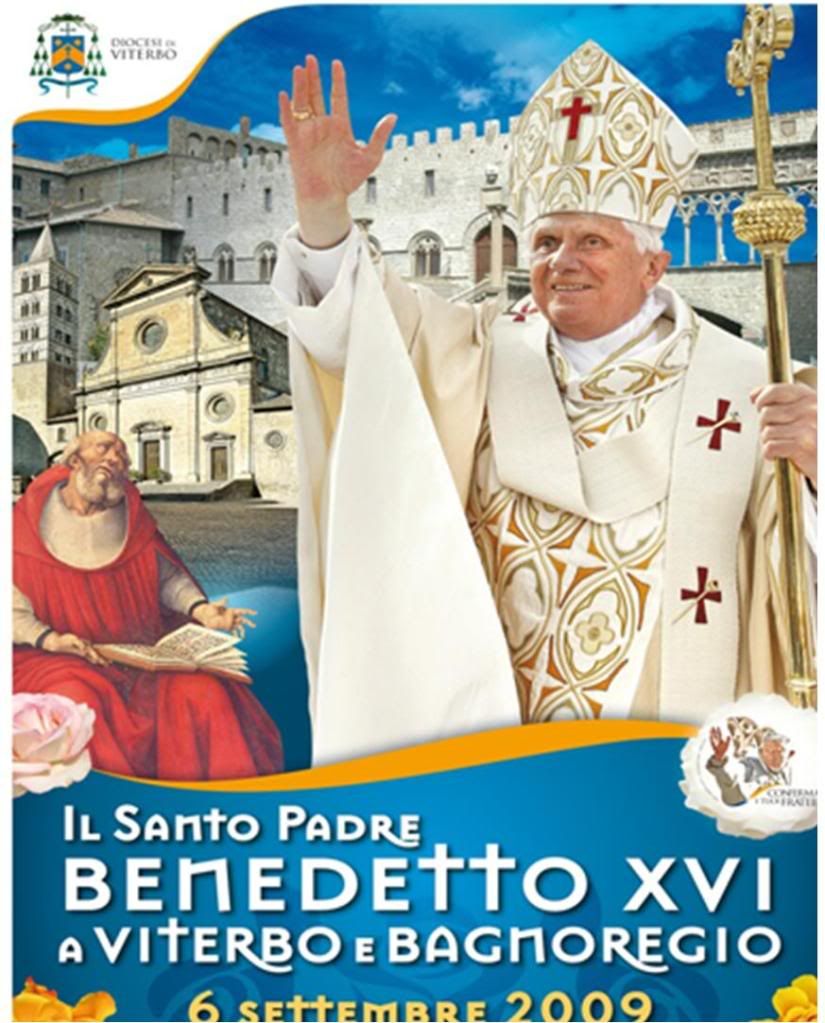
The site of the Diocese of Viterbo
dedicated to the Pope's visit:
www.ilpapaaviterbo.it/
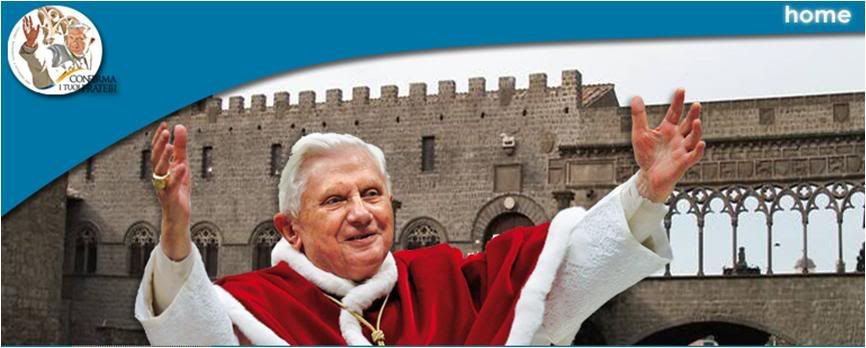 NB: The common element in the logo, the poster and the banner of the papal visit site is the distinctive loggia of the Palazzi dei Papi in Viterbo. The poster has the additional elements of the Cathedral of St. Nicholas and St. Bonaventure..
NB: The common element in the logo, the poster and the banner of the papal visit site is the distinctive loggia of the Palazzi dei Papi in Viterbo. The poster has the additional elements of the Cathedral of St. Nicholas and St. Bonaventure..
[Modificato da TERESA BENEDETTA 16/08/2009 22:54] |
| |
 16/08/2009 21:31 16/08/2009 21:31 |
|
| | | OFFLINE | | Post: 18.202
Post: 860 | Registrato il: 28/08/2005
Registrato il: 20/01/2009 | Administratore | Utente Senior | |
|

Posted 8/1/09 in the BENEDICT thread:
The Pope's coming pastoral visit:
Between Bonaventure and Thomas Aquinas
Translated from

The Pope's visit to Viterbo and Bagnoregio on September 6 will be a trip in the footsteps of St. Bonaventure.
According to the official program released by the Vatican this week, Benedict XVI will celebrate Mass in Viterbo's Valle Faul in the morning, after which he will make a brief stop at to the shrine of St. Rose, patron of the city.
Int eh afternoon, a private visit to the shrine of the Madonna della Quercia (Our lady of the Oak) and then go by helicopter to nearby Bagnoregio, birthplace of St. Bonaventure, whose relic he will venerate in the Cathedral of St. Nicholas. The visit ends with a meeting with the townspeople in Piazza San Agostino.
The Pope has never hidden his attraction to the thought of St. Augustine and the Augustinian school, of which the Franciscan St. Bonaventure was the most outstanding representative.
At the same time, Joseph Ratzinger has expressed great appreciation for St. Tomas Aquinas, a Dominican and the Thomist school.
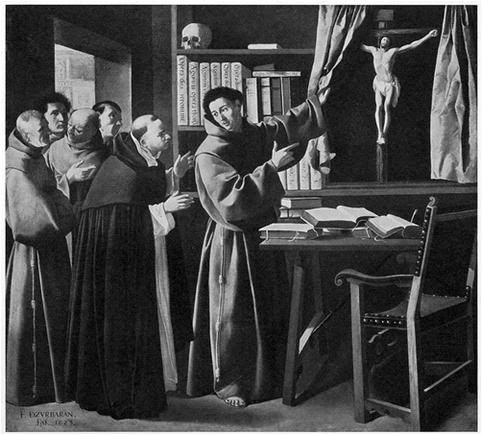 Francisco Zurbaran, Bonaventure shows Thomas Aquinas the Crucifix, 1629.
Francisco Zurbaran, Bonaventure shows Thomas Aquinas the Crucifix, 1629.
Bonaventure and Thomas were contemporaries [and studied together in Paris] in the 13th century, and advocated two different but complementary versions of reality.
For Bonaventure, the way to Truth is divine enlightenment, 'a mystic fact'. It requires, he said, "grace, not science, desire, not intellect, the aspiration of prayer, not the need to read". True wisdom, he thought, could be achieved only if one loves Christ to the point of sharing the Cross with him.
Benedict XVI said about Bonaventure in the General Audience on May 14, 2008:
"Love sees more than reason ... love sees, love is an eye, and experience gives us more than reflection. And Bonaventure saw such experience in the life of St. Francis: the experience of a very humble path, very realistic, this day-to-day walking with Christ, accepting his Cross.
"In this poverty and this humility, in the humility which one can live even in ecclesiality, there is an experience of God that is higher than that which one achieves through reflection, one in which we truly touch the heart of God".
For his part, St. Thomas achieved an 'admirable synthesis' of reason and faith: "Reason, illuminated by faith, finds the power to raise itself to the knowledge of God and spiritual realities," the Pope has said, addressing today's society in which reason is increasingly weak and incapable of admitting "the existence of any truth".
He exhorts us "to rediscover human rationality in a new way", and to have great trust in reason. He calls on Christians to know "how to express the reasonableness of their faith", bearing witness to it "in a dialog inspired by love".
"If we look at the great options, the Christian option is, even today, the most rational adn the most human. Thus we can confidently elaborate a philosophy, a vision of the world which is based on this priority of reason, on this trust that creative Reason is love, and that this love is God", the Pope said in an encounter with the young people of the Diocese of Rome in April 2006.
St. Bonaventure and St. Thomas - two theologians at the head of two schools of thought which, for centuries, have contended at the philosophical and theological levels.
Two saints who, through different ways, dedicated their lives to the Gospel, to Jesus, and achieving their birth in heaven in the same year, 1274.
[The RV reporter inexplicably fails to cite the one text in which Benedict XVI has spoken of Thomas Aquinas - an Angelus homily on 1/28/07, the liturgical feast of St. Thomas. It can be found on
freeforumzone.leonardo.it/discussione.aspx?idd=354486&p=12
Fr. Schall made it the subject of one of his essays at the time.]
[Modificato da TERESA BENEDETTA 16/08/2009 22:53] |
| |
 16/08/2009 21:41 16/08/2009 21:41 |
|
| | | OFFLINE | | Post: 18.203
Post: 861 | Registrato il: 28/08/2005
Registrato il: 20/01/2009 | Administratore | Utente Senior | |
|


Posted 8/12/09 in the BENEDICT thread:
For this item, thanks to Lella and her blog
 Tentative program for Pope's visit
Tentative program for Pope's visit
to Brescia on November 8
by MASSIMO TEDESCHI
Translated from

August 11, 2009
The Holy Father's visit to Brescia on November 8 is shaping up and appears to include the following:
A visit to the memorial in the central Piazza della Loggia to the eight persons killed and 94 injured by a bomb that went off during a demonstration in May 1984. Members of a neo-fascist group along with high-ranking members of the local carabinieri were later tried for the crime.
A Mass at the Piazza Paolo VI.
A meeting with the faithful of Concesio, the suburban town where Paul VI was born.
Inaugurating the new headquarters of the Istituto Paolo VI located next to the Montini family home. Here, he is expected to make a major address on the life and work of Papa Montini.
It is also thought he may make a stop in the morning at Botticino, another Brescia suburb, to pay homage to St. Arcangelo Tadini, one of the saints he canonized last April.
Tadini (1846-1912) was a model parish priest who tirelesssly promoted the sacraments and the liturgy, but also, at the time of the Industrial Revolution, worked actively in behalf of workers and their families and founded the order of the Workers' Sisters of the Holy House of Nazareth.
The program will be finalized after an on-site visit expected in the next several days by Vatican security and representatives of the Pontifical Household.
Brescia mobilized twice before for a pastoral visit by John Paul II - in September 1982 and again in September 1998.
In announcing Benedict XVI's visit last April, Bishop Luciano Monari said: "The reason for this visit is the 30th anniversary of the death of Paul VI. [One year late, because last August 6 was the 31st anniversary.] Papa Ratzinger was made a cardinal by Paul VI and has always shown great love and appreciation for our Brescian Pope. So he will come and share with us a day which shall be one of great communion and prayer".
The Pope will be arriving at Ghedi airport around 9 a.m., and it is during the trip from the airport to the center of Brescia that he may make the stop at Botticino to venerate St. Arcangelo Tadini.
In this case, he would meet the faithful briefly at the central square which is surrounded by all the principal places in which the saint carried out his pastoral work and apostolate.
[Modificato da TERESA BENEDETTA 16/08/2009 22:52] |
| |
 16/08/2009 21:43 16/08/2009 21:43 |
|
| | | OFFLINE | | Post: 18.204
Post: 862 | Registrato il: 28/08/2005
Registrato il: 20/01/2009 | Administratore | Utente Senior | |
|

Posted 8/14/09 in the BENEDICT thread:
The Italian newspapers yesterday buzzed with reports that Prime Minister Silvio Berlusconi is supposedly determined to be in Viterbo for the Pope's coming visit, with the insinuation that this would be unseemly in view of Berlusconi's widely reported extra-marital indiscretions for which his wife is seeking to divorce him.
AGI reports a response from the Vatican.
It's entirely up to Berlusconi,
Vatican officials say
By SALVATORE IZZO

VATICAN CITY, August 14 (translated from AGI) - "When the Pope makes a pastoral visit, the civilian authorities who welcome him always include those who represent the Italian nation, and thus honor him with their presence. It is up to the government to decide whom these representatives should be".
This was underscored to AGI today by a Vatican dignitary who is usually part of the Pope's entourage on his trips away from the Vatican.
"It is never the case that the Pontiff refuses to meet the representatives of the Italian government, since it is his duty to welcome them and listen to them - in the interests of continuing dialog on matters of peace, justice and the defense of the values that the Catholic Church advocates for the Catholic community and in behalf of the weakest members of society," he continued.
"Therefore, if it is Prime Minister Berlusconi who will represent the national government in Viterbo on September 6, Benedict XVI will be just as happy."
Already last July, Vatican press director Fr. Federico Lombardi, had brushed aside reports that Berlusconi had been denied a papal audience on the occasion of the G8 summit In Italy, saying that it had not been requested. [Also, the Pope had written a widely publicized letter to Berlusconi, in his capacity as current G8 president, on the eve of the G8 summit to articulate his hopes for positive action by the rich nations towards the poorer ones, especially those in Africa.]
At the same time, it is obvious that governments seek to respect the Pope's opportunity for a rest period in summer, when his public activities are reduced to a minimum.
This respect is particularly dutiful on the part of the Italian government, whose representatives have more opportunities than those from other nations to meet with the Pope during the rest of the year.
Moreover, there have been no reports in recent memory of any papal audience that was denied or postponed for any reason such as those suggested by the Italian media about Berlusconi (his personal life).
An exception was Pius XII's refusal to meet with Italy's postwar Prime Minister Alcide De Gasperi, who had requested a private audience to mark his wedding anniversary shortly after tensions had developed with the Vatican over some policy decision by De Gasperi's Christian Democratic government.
On the other hand, John Paul II defied widespread objections against meeting with then Austrian President Kurt Waldheim, ex-Secretary General of the United Nations, who had admitted his wartime association with the Nazis.
The Vatican said then that the Pope could not possibly refuse to meet a head of state who had been legitimately elected.
It will also be recalled that Pius XI would have been willing to meet with Adolf Hitler in 1938 when the latter came to visit Italy in order to speak to him directly about stopping anti-Catholic persecution in Germany.
But the Pope was constrained to leave the Vatican for Castel Gandolfo before Hitler arrived to avoid the embarrassment that Hitler was coming to Rome but not to the Vatican.
So many other personages judged negatively by history have been received at the Apostolic Palace with all the honors due any visiting head of state or government - from Zaire dictator Mobutu to the Sandinista Daniel Ortega whose government included many priests defiant of the Church.
"The Pope welcomes all visitors without raising an accusing finger. He is, after all, the Successor of Peter, whom Jesus pardoned even if he had denied him three times," the Vatican prelate noted.
Italian leaders, of course, do not lack for opportunities to meet the Pope if they wish to. In June 2007, for example, then Prime Minister Romano Prodi showed up to welcome Benedict XVI to Assisi the day after three of his ministers took part in a Gay Pride parade in Rome which featured terrible accusations made in public against Benedict XVI and his private secretary. [I had not previously read anything about these before - apparently, the Italian media exercised a rare but praiseworthy editorial discretion at the time, although they reported the usual 'obscurantist' rants agains the Pope.]
But Prodi's presence was seen as an act of respect intended to make up somehow for those offenses.
 Another huge buzz in the Italian media these days is over a recent decision by a regional court affecting the rights of Catholic teachers of religious instruction in Italy's public schools, where an hour of religious instruction every week is mandated under the terms of the Vatican Concordat with the Italian government - and in view of Italy's history and overwhelmingly Catholic population.
Another huge buzz in the Italian media these days is over a recent decision by a regional court affecting the rights of Catholic teachers of religious instruction in Italy's public schools, where an hour of religious instruction every week is mandated under the terms of the Vatican Concordat with the Italian government - and in view of Italy's history and overwhelmingly Catholic population.
Although attendance is not mandatory, 90 percent of Italian schoochildren (obviously with their parents' consent) have chosen to attend these classes consistently over the past several decades, for which they get scholastic credit. Those who opt not to attend religious instruction can choose other activities as a substitute and get equivalent credit. (By the way, the 'religious instruction' is deliberately not Catholic catechesis but rather a cultural appreciation of what Catholicism has meant to the Italian nation. For this reason, many non-Catholic children also attend the classes.)
Apparently, the court decision has to do with such credits, and with the credentialling status of the religious instructors, usually provided by the diocese but paid by the state. I can't understand all the intricacies, but the Italian bishops' conference is protesting the court decision as an attempt to do away with the religious instruction mandate, and a judiclal rejection of guidelines issued years ago by the Italian ministry of education.
I am hoping Sandro Magister will come up with a summary soon that the non-Italian public can understand and appreciate.
[Modificato da TERESA BENEDETTA 16/08/2009 22:52] |
| |
 16/08/2009 22:51 16/08/2009 22:51 |
|
| | | OFFLINE | | Post: 18.205
Post: 863 | Registrato il: 28/08/2005
Registrato il: 20/01/2009 | Administratore | Utente Senior | |
|
 25 years since a Pope
25 years since a Pope
last visited Viterbo -
'city of Popes'
by Mario Ponzi
Translated from
the 8/15/09 issue of

The 'city of Popes' is preparing to receive yet again a Successor of Peter within its venerable walls. Benedict XVI will visit the city in upper Lazio on Sunday, September 6.
For the Viterbans,, it is an occasion to recall their millennially ancient history - Etruscan, Roman and Christian. A revisiting that is significant, because Viterbo up to now has lived more entrenched in its storied past, which has given it some sense of balance, rather than looking toward the future which is far from hopeful for a land dependent on agriculture and small peasant holdings.
Viterbo's farmlands extend between Amiata and Cimino, the two mountains that the ancient Etruscans considered as divinities that protected the farms from bad weather coming from the north and south.
Laterally, it extends from the Tiber to the Tyrrhenian Sea, enclosing a valley that receives the sun directly every day, which has always assured fertile lands and a pleasant healthy climate.
That geography has much to do with why the Etruscans decided to settle in these lands, why the Romans considered it a guaranteed asset for the imperial treasury, and why the Popes sought refuge there from an uncertain and hostile Rome.
And they all left obvious signs of their passage through the land. But what represents the most authentic synthesis of Viterbo's three civilizations is and continues to be the native pure-blooded Viterban who carries in himself the characteristics of his three ancestral civilizations - Etruscan humanism, Roman stability, and the Christian balance between divine and natural virtues.
The Viterban conserves within himself the most beautiful treasures of humanity that are his true legacy. One only has to observe attentively and look deeply into each of them - even a simple shepherd in the mountains of the Maremma - to be aware of this. They are the very traits that have resonated in the Latin classics of Virgil, Cicero and Horace.
To speak to the Viterbans today is like listening to their forefathers who left them their teachings in the form of proverbs that are preserved like a sacred treasure and as a common and sure reference point for all Viterbans.
It is evident that the people of upper Lazio have great interior riches. Of all the lords that have come and gone in their history, they remember only the Popes as fathers, benefactors, attentive pastors and generous patrons.
And so Viterbo's appellation as 'city of Popes' is not so much because it had been the residence of Popes, but because Viterbans are 'papists' at heart, who have always shown fidelity and loyalty to the Popes as Successors of Peter, whoever Pope it is.
Thus the grand welcome they gave John Paul II in May 1984, when he became the first Pope to set foot in Viterbo in 127 years. It was a one-day visit that lasted all of 13 hours, nonetheless - the longest he had ever spent in an Italian city outside Rome up to that time.
It was May 27, the last Sunday of the month. He was accompanied by Cardinal Sergio Guerri, a native of Tarquinia [the most famous ancient Etruscan city in Lazio]. The Pope had ten engagements - starting with a visit to the prison of Santa Maria in Gradi and ending with a meeting with the wards of the St. Crispin center for recovering drug addicts.
Three moments of prayer remain etched in the minds of those who followed the Pope's day: in the morning, before the urn containing teh relics of the city's patron Saint Rosa; then in the Cathedral while venerating the relics of Saints Valentine and Hilarius, who had come from the Orient to found the Church of Viterbo; and in the afternoon, at the Basilica of St. Francis, at teh tombs of two Popes, Celestine IV and Adrian V (whose pontificate lasted only 38 days, just a little more than Papa Luciani's 33 days).
"At every step", the news reports of the day said, "John Paul II came across documents and testimonials of great importance. In the Cathedral of St. Lawrence, for instance, he stopped with interest at the tomb of Pope John XXI, who was Portuguese and who died because of a fall in the Palace of the Popes. In the Augustinian cloisters, where he met with some sick persons, every stone spoke of an ancient and glorious scientific tradition of which the monk Mendel was but the principal symbol. Or his visit to the shrine of the miraculous Madonna della Quercia (Our Lady of the Oak)... The list goes on and on, and one thing was certain: by the time his visit ended in the evening, John Paul II had amassed quite a number of great sensory impressions."
His meeting with the recovering drug addicts of St. Crispin center was certainly the most socially relevant and significant event of his visit. The Pope chose to receive the patients and their parents at the historic Conclave Hall of the Palace of the Popes.
He discarded his prepared speech, and in praising the efforts by the young people to emerge from their imprisonment in drugs, he said:
"The essential success is always man himself, man who recovers his humanity, his sense of being human, and therefore, his sense of the future.... Drugs cannot be conquered by other drugs but by a serious commitment on the part of all concerned, including the community... Replacement drugs [which, at the beginning of some addiction therapy, substitute for the addictive substance but do not have their harmful effects] are not sufficient therapy but rather5 constitute a veiled way of surrendering to the drug itself".
He continued: "The way to leave the hallucinatory world of addictive drugs is the mobilization of everyone (to form) a new society to the measure of man, the education to be real men."
Today, at a distance of 25 years, the same city - which is different because it has grown and is in the grip of old and new problems, but remains faithful to its papist soul - is preparing to receive another Pope, Benedict XVI.
The logo that the diocese has prepared for his visit states that faithful Viterbo hopes to be confirmed in its faith by the Successor of Peter, so that it may be able to resist the challenges of a secularism that is increasingly invasive and increasingly more difficult to oppose.

[Modificato da TERESA BENEDETTA 16/08/2009 22:56] |
| |
 22/08/2009 19:52 22/08/2009 19:52 |
|
| | | OFFLINE | | Post: 18.245
Post: 901 | Registrato il: 28/08/2005
Registrato il: 20/01/2009 | Administratore | Utente Senior | |
|
 Posted earlier in the BENEDICT XVI NEWS thread;
Viterbo ready for the Pope
Posted earlier in the BENEDICT XVI NEWS thread;
Viterbo ready for the Pope
by AUGUSTO CINELLI
Translated from

August 21, 2009
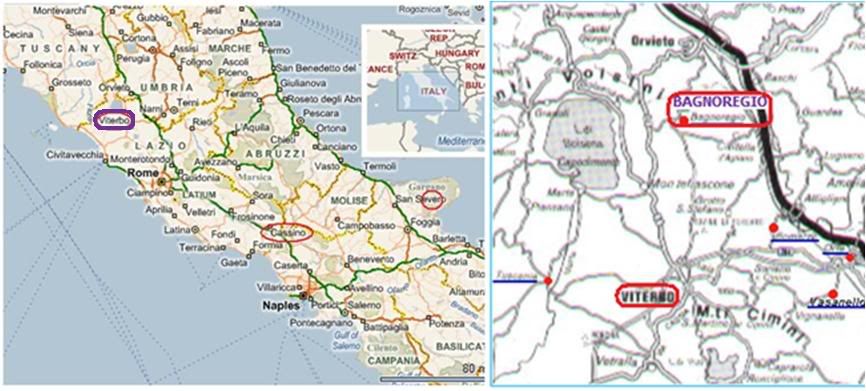
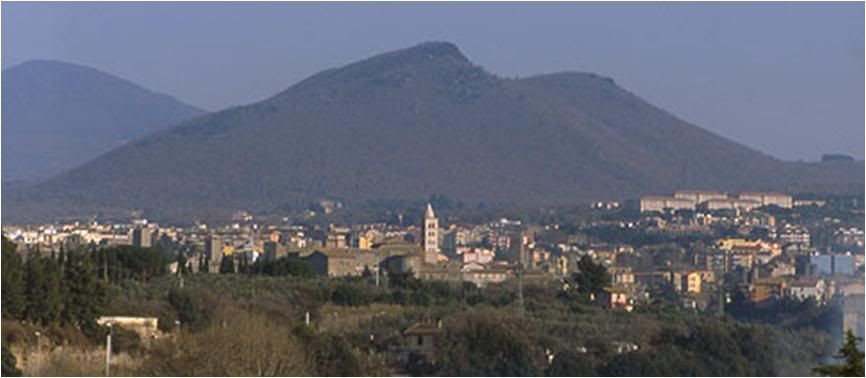
Fifteen days away from the pastoral visit of Benedict XVI to Viterbo and Bagnoregio on Sunday, Sept. 6, there is great ferment in the diocese of Viterbo and in all of the territory of Tuscia.
[Tuscia is the term for what was the heartland of Etruscan culture in Italy, a region bordering Tuscany, Umbria and the Rome metropolitan region, with Viterbo as its center. Present-day Tuscia occupies the northern part of the region of Lazio which includes the province and city of Rome.]
Organizers are placing the finishing touches to the preparations for the visit which is a collaboration between the Diocese and local institutions.
It will be the first papal visit to Viterbo since the creation in 1986 of the present Diocese of Viterbo from the reunification of five ancient dioceses - Viterbo, Tuscania, Motnefiascone, Bagnoregio and Acquapendente.
And it will be the second papal visit to the medieval City of the Popes since John Paul II visited in 1984; for Bagnoregio, hometown of St. Bonaventure, the first by a Pope.
Perhaps the choice of Viterbo for a papal visit was also dictated by Pope Benedict's personal connection to St. Bonaventure, a Doctor of the Church ('the Seraphic Doctor') and contemporary of St. Thomas Aquinas, who was born Giovanni Fidenza in Bagnoregio around 1217. [He was renamed Bonaventura (good fortune) after he was miraculously healed of a childhood illness by St. Francis of Assisi.
Bonaventure's theology of history was the subject of Fr. Joseph Ratzinger's dissertation in 1957 to qualify for his Habilitation as a German university professor. First published two years later in the original German under the title St. Bonaventure: The theology of history, it was recently re-published in Italy.
Thus, in the afternoon of his visit to Viterbo, the Pope will fly by helicopter to Bagnoregio and venerate the only relic of the saint in Italy, the 'holy arm' kept in the co-cathedral of San Nicola. {The rest of his body is in Lyon, where he died in 1284.)
The high point of the visit will be the Eucharistic celebration to start around 10:15 at the Valle Faul, the plain below the elevation on which the Palazzo dei Papi and the Cathedral of San Lorenzo are located.
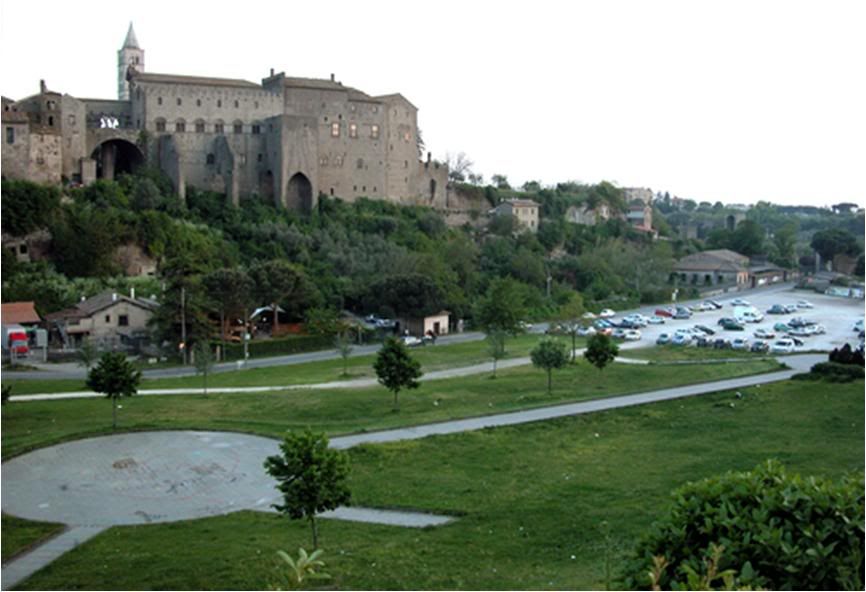
The organizers said that the plain has been prepared to accommodate the altar-stage for the Mass and a crowd of at least 10,000 who can be accommodated for the Mass adn the Angelus.
There will be jumbo TV screens at certain points of the city for those who have not tickets to the Mass.
Concelebrating with the Pope will be Cardinal Agostino Valli, the Pope's Vicar for the Diocese of Rome, 30 bishops from teh Lazio region adn at least 200 diocesan priests.
The Pope will also be paying homage to the other patron saints of the diocese - St. Rosa, co-patron of the city, and the Madonna della Quercia, a miraculous image of Mary venerated in a shrine outside Viterbo. (The shrine includes a monastery where the Pope will have lunch and his customary post-luncheon rest before undertaking his afternoon program.)
Since the day the pastoral visit was officially announced last December 8, the church community in Viterbo embarked on an intense program of spiritual preparation, with periodic interventions by the Bishop of Viterbo, Mons. Lorenzo Chiarinelli, who has said in his welcoming message: "The Church of Viterbo which has always been linked to Peter's Chair, welcomes the Successor of Peter to be confirmed in the faith,and with confidence in the future, cultivating among so many local examples of holiness, the fascinating message of St. Nonaventure of Bagnoregio".
The bishop has met with representatives of the various parishes and local church associations to give pointers on what must be emphasized to the faithful in their spiritual preparation.
He also appeared before the communal councils of both Viterbo adn Bagnoregio, meeting in extraordinary session, to describe the preparations for the visit. Last Wednesday, he met with the youth volunteers who will be assisting the faithful on the day of the visit.
Viterbo, where the Papal Conclave was born
Translated from

August 21, 2009
Benedict XVI will be the 55th Pontiff to visit Viterbo, which prides itself as the medieval City of the Popes.
Five Popes were elected here, and four of them are buried here.
In fact, from 1227-1281, Viterbo was the seat of the Papacy for political and military reasons, not to mention the therapeutic properties of its thermal springs, for which the city was known before then.
The papal residence was established in the Bishop's palace which was enlarged and renovated to the magnificence befitting a papal residence.
 Front and rear views of the Palazzo dei Papi.
Front and rear views of the Palazzo dei Papi.
The complex - a symbol of medieval Viterbo - is known today as the Palazzo dei Papi, best known for its Conclave Hall.
The term 'conclave' from the Latin cum clave (under lock and key) was coined here on tehe occasion of the longest papal election in history: 36 months and a day.
In 127q1, the Viterbans, tried of three years of indecisions by the cardinals meeting to elect a success for Urban IV, locked them in the Great Hall of the apostolic palace, opening a part of the roof to give them air while they decided. And they did, within one day, electing Gregory V.
A new book, Viterbo e i Papi, prepared for the occasion of the papal visit, reconstructs after careful research the story of the presence of Popes in Viterbo up to the visits by Pius IX in 1857 and by John Paul II in 1984.
The book, written by Mons. Salvatore Del Ciuco, will be presented in a special edition to Benedict XVI, as well as to civilian authorities.
It contains previously unpublished accounts of the first Conclave of Viterbo, particularly the role played by St. Bonvaneture in appealing to the cardinals to come to an agreement on their choice for Pope.
In this context, Benedict XVI's visit is seen as a splendid seal for the new millennium nine centuries after the Popes first came to Viterbo.
|
| |
 03/09/2009 14:31 03/09/2009 14:31 |
|
| | | OFFLINE | | Post: 18.328
Post: 983 | Registrato il: 28/08/2005
Registrato il: 20/01/2009 | Administratore | Utente Senior | |
|
 Updating the thread-
Updating the thread-
Posted 8/25 in BENEDICT XVI NEWS:
It was always obvious that the Pope's trip to Bagnoregio during the visit to Viterbo was his way of paying homage to St. Bonaventure, but it is most gratifying to find out that Robert Moynihan himself was a scholar on Bonaventure and has thus written this instructive essay:
Benedict XVI and Bonaventure:
The Pope's trip to Bagnoregio
is more significant than it seems
By Robert Moynihan

ROME, AUG. 24, 2009 (Zenit.org).- Sometimes, there is more to a papal trip than meets the eye.
And that is the case with an upcoming trip of Benedict XVI to the small Italian town of Bagnoregio, the birthplace of St. Bonaventure.
In two weeks, on Sept. 6, the Pope will go out of Rome to visit Bagnoregio and Viterbo.
Viterbo, about 65 miles north of Rome, or just an hour by car, is well-known as the place where papal conclaves were born.
Until 1271, the gathering of cardinals for the election was not called a "conclave" ("con" meaning "with" and "clavis" meaning "a key") -- a closed meeting in a place locked "with a key."
After the death of Pope Clement IV in 1268, the cardinals meeting in Viterbo did not elect anyone for almost three years. Finally, the city officials locked all of them in a meeting room and gave them only bread and water to eat. Soon after, they elected Pope Gregory X. He then made it Church law that papal elections would take place in a conclave.
Benedict XVI will travel to Viterbo by helicopter from the papal summer villa at Castel Gandolfo, south of Rome.
But on his way home, he will stop in Bagnoreggio.
Why stop in such a little, seemingly unimportant town?
Because St. Bonaventure was born there in 1217.
Still, the Pope does not stop at the birthplace of every important saint. He would not have time to do so. So, why is he taking time to stop in Bonaventure's place of birth?
For the answer, we have to look into the Pope's own past, and there we find something rather interesting.
We find that Bonaventure was one of the two major intellectual influences on Pope Benedict's entire theological formation. (The other influence? St. Augustine.)
In Germany, scholars must write two dissertations. The first, as in the United States, is to receive a doctoral degree (a Ph.D.). The second, called the 'Habilitationsschrift', is to qualify for a professorial post.
And the young Joseph Ratzinger, in the mid-1950s, wrote this second, postdoctoral thesis, on ... St. Bonaventure, and his understanding of history.
Press accounts will say that the Pope is "scheduled to venerate the 'holy arm' of the saint, which is kept in Bagnoregio's cathedral" (the rest of St. Bonaventure's body is buried in France).
But Benedict is venerating also the deep wisdom of Bonaventure's vision of Christian revelation, and in so doing "making contact" with one of the central concerns of his own personal theological vision.
In this sense, if we can understand what Benedict learned from Bonaventure, we can understand more clearly what Benedict is trying to do now, in his pontificate, to lead the Church through this complicated period in history.
Benedict XVI himself gave us an idea of this intellectual background in a speech he gave to a group of scholars several years ago, before he was Pope.
He said this: "My doctoral dissertation was about the notion of the people of God in St. Augustine. ... Augustine was in dialogue with Roman ideology, especially after the occupation of Rome by the Goths in 410, and so it was very fascinating for me to see how in these different dialogues and cultures he defines the essence of the Christian religion. He saw Christian faith, not in continuity with earlier religions, but rather in continuity with philosophy as a victory of reason over superstition. ..."
So, we might argue that one major step in Ratzinger's own theological formation was to understand Christianity as "in continuity with philosophy" and as "a victory of reason over superstition."
Then Ratzinger took a second step. He studied Bonaventure.
"My postdoctoral work was about St. Bonaventure, a Franciscan theologian of the 13th century," Ratzinger continued. "I discovered an aspect of Bonaventure's theology not found in the previous literature, namely, his relation with the new idea of history conceived by Joachim of Fiore in the 12th century.
"Joachim saw history as progression from the period of the Father (a difficult time for human beings under the law), to a second period of history, that of the Son (with more freedom, more openness, more brotherhood), to a third period of history, the definitive period of history, the time of the Holy Spirit.
"According to Joachim, this was to be a time of universal reconciliation, reconciliation between east and west, between Christians and Jews, a time without the law (in the Pauline sense), a time of real brotherhood in the world.
"The interesting idea which I discovered was that a significant current among the Franciscans was convinced that St. Francis of Assisi and the Franciscan Order marked the beginning of this third period of history, and it was their ambition to actualize it; Bonaventure was in critical dialogue with this current."
So, we might argue, Ratzinger drew from Bonaventure a conception of human history as unfolding in a purposeful way, toward a specific goal, a time of deepened spiritual insight, an "age of the Holy Spirit."
Where classical philosophy spoke of the eternity of the world, and therefore of the cyclical "eternal return" of all reality, Bonaventure, following Joachim, condemned the concept of the eternity of the world, and defended the idea that history was a unique and purposeful unfolding of events which would never return, but which would come to a conclusion.
History had meaning.
History was related to, and oriented toward, meaning -- toward the Logos ... toward Christ.
This is not to say that Ratzinger - or Bonaventure - made any of the specific interpretations of Joachim his own. It is to say that Ratzinger, like Bonaventure, entered into "critical dialogue" with his overall conception -- that history had a shape and a meaning -- that he, like Bonaventure, took it quite seriously.
I have some personal insight into how seriously Ratzinger took these matters.
My own doctoral research was on the influence of the thought of Joachim on the early Franciscans.
When I first met Joseph Ratzinger, in the fall of 1984, I told him I was studying his book on St. Bonaventure with interest, and he replied: "Ah! You're the only one in Rome who has read that book of mine."
Then, later, he commented to me that the liberation theology of the Brazilian Franciscan Father Leonardo Boff was a "modern form" of Joachimism - a desire to see within history a new ordering of human society.
So I am persuaded that Ratzinger took his research into Bonaventure quite seriously.
Ratzinger received his degree on Feb. 21, 1957, at nearly 30 years of age, but not without controversy.
The academic committee judging his work actually rejected the "critical" part of his thesis, so he was obliged to cut and edit it, and present the "historical" part only, centered on the analysis of the relation between St. Bonaventure and Joachim of Flora.
Ratzinger's professor, Michael Schmaus, thought Ratzinger's interpretation of Bonaventure's concept of revelation showed "a dangerous modernism that had to lead to the subjectivization of the concept of revelation," as Ratzinger himself recalls in his autobiography, Milestones: Memoirs 1927-1977. (Ratzinger felt, and still feels, that Schmaus's criticisms were not valid.)
What was it that Ratzinger found in Bonaventure that aroused such controversy?
For Ratzinger, Bonaventure's concept of revelation did not mean what it does for us today, that is, "all the revealed contents of the faith."
In Ratzinger's view, for Bonaventure, "revelation" always connoted the idea of action -- that is, revelation means the act by which God reveals himself, and not simply the result of this act.
Why is this important?
Ratzinger wrote in Milestones: "Because this is so, the concept of 'revelation' always implies a receiving subject: where there is no one to perceive 'revelation,' no re-vel-ation has occurred, because no veil has been removed. By definition, revelation requires a someone who apprehends it."
And why does this matter?
"These insights," Ratzinger continued, "gained through my reading of Bonaventure, were later on very important for me at the time of the conciliar discussion on revelation, Scripture, and tradition. Because, if Bonaventure is right, then revelation precedes Scripture and becomes deposited in Scripture but is not simply identical with it."
"This in turn means that revelation is always something greater than what is merely written down. And this again means that there can be no such thing as pure sola scriptura ["by Scripture alone"], because an essential element of Scripture is the Church as understanding subject, and with this the fundamental sense of tradition is already given."
In essence, what Ratzinger drew from Bonaventure modified and completed what he had drawn from Augustine.
If Augustine's thought emphasized the continuity of Christianity with classical philosophy, and the "reasonableness" of Christian faith over against pagan superstition, Bonaventure's thought emphasized the contrast between Christianity and classical philosophy, indeed, condemned the futility of classical philosophy, with its embrace of the concept of the eternity of the world and the "eternal return" of all things, because it lacked the revealed truth of a divine "actor."
Ratzinger suggested this in the forward to his work on Bonaventure: "Has not the ‘Hellenization' of Christianity, which attempted to overcome the scandal of the particular by a blending of faith and metaphysics, led to a development in a false direction? Has it not created a static style of thought which cannot do justices to the dynamism of the biblical style?"
Even today, if we go to the last chapter of the Pope's recent book, Jesus of Nazareth, we find the metaphysical terminology that presupposes an ontology of " person as relation" [How I love this central concept in Ratzinger's thought! And that it starts with God himself as Trinity, so that man by himself is meaningless without his relationship to God and to other human beings] that I believe is the "golden thread" throughout all of Ratzinger's work, from his first book on Augustine, begun in 1953, through his "habilitation thesis" on Bonaventure (1956) to his recent Jesus of Nazareth (2007).
Ratzinger is saying that Christian revelation must always transcend reason, though it does not, and must not, contradict it.
When Benedict XVI visits Bagnoregio, then, he will be, in a sense, returning to the source of his own deepest intellectual struggles, to the place where he came fully to understand the newness of the Christian faith, and how that faith, that revealed truth, is at one and the same time in harmony with, and at total opposition to, the "reason" which was the highest good of classical philosophy.
This makes the trip to Bagnoregio far more than another papal trip; it is a trip into Ratzinger's own intellectual and spiritual past, and into the core of his intellectual and spiritual vision.
Robert Moynihan is founder and editor of the monthly magazine Inside the Vatican, and author of the book Let God's Light Shine Forth: the Spiritual Vision of Pope Benedict XVI (2005, Doubleday).
In February last year, an Italian edition of Prof. Ratzinger's Habilitation dissertation on St. Bonaventure was published.
Fr. Ratzinger's book on
St. Bonaventure to be
presented in Rome on Feb. 26
Translated from
the Italian service of

ROME, Feb. 12, 2008 (ZENIT.org) - The Italian edition of Joseph Ratzinger's 1957 'Habilitation' thesis on St. Bonaventure will be presented at the Antonianum Pontifical University in Rome on Feb. 26

"My post-doctoral work was centered on St. Bonaventure, a Franciscan theologian of the 13th century," Cardinal Ratzinger recalled in his self-presentation speech when he became a member of the Pontifical Academy of Sciences on November 13, 2000. "To discover an aspect of St. Bonaventure's theology that, as far as I new, had no literary precedent - and that was his new idea of history."
Ratzinger worked on the thesis in 1957 to get his 'Habilitation' or license to be a professor at a German university.
The academic presentation, which will start at 4 p.m., will be presided by Cardinal Claudio Hummes, prefect of the Congregation for the Clergy.
The round table discussion, to be moderated by Prof. Barbara Faes de Mottoni of the National Research Center, will have the following participants: Mons. Angelo Amato, secretary of the Congregation for the Doctrine of the Faith; Prof. Paolo Vian of the Vatican Apostolic Library (brother of Osservatore Romano editor Gianmaria Vian); and Fr. Johannes Baptist Freyer, Rector of the Antonianum.
Fr. Pietro Messa, president of the university's School for Medieval Studies, and Franciscans who collaborated in the publication of the volume, explained to ZENIT that current interest in the Pope's book 50 years after he wrote his thesis, was that "to understand the thinking of Pope Benedict XVI, which characterizes his Pontificate so much, it is not possible to ignore his early formation."
In his speech to the Pontifical Academy of Sciences in 2000, Cardinal Ratzinger recalled that in the 12th century, Joachim of Fiore had understood history as 'the progression from the age of the Fathr (a difficult time for human beings under the law), to a second historical age, that of the Son (with more freedom, directness and brotherhood), to a third age of history, its definitive period, the time of the Holy Spirit."
"According to Joachim," Ratzinger said, "this ought to be the time of universal reconciliation, between Easy and West, between Christians and Jews, an era without laws (in the Pauline sense), a time of true fraternity int he world. The interesting idea was to discover that a significant current of thought among Franciscans was convinced that St. Francis of Assisi and the Franciscan Order marked the beginning of this third era in history, and it was their ambition to actualize it. Bonaventure kept up a critical dialog with this current."
Fr. Messa said that young Fr. Ratzinger's work "was subsequently taken up in many studies on the theology of St. Bonaventure, ass indicated in the bibliography that is an appendix to this volume, which indicates the importance it has in studies on Bonaventure."
"Thanks to this text," he said, "research has progressed and some conclusions have changed because of this progress, but also because wee can now benefit from many more critical references compared to those available to Ratzinger in 1957."
As for the role of the thesis in the formation of benedict XVI, Fr. Messa said "there are many elements found in this study which can be re-encountered in the Pope's Magisterium", like the centrality of Christ that St. Bonaventure maintained, which is fully present in the Pope's teachings and illustrated by his book on Jesus."
When asked whether through St. Bonaventure, Franciscanism would recover an important role in the exercise of Benedict's Papacy, Fr. Messa recalled the words of the great French theologian Yves Congar: "It was precisely from this study and the problem of the relationship between the local Church and the universal Church, which was much debated after Vatican-II, Congar wrote: 'Joseph Ratzinger, who has made us note, quite wright I think, some differences between Bonaventure and Thomas Aquinas, gives a lot of importance to the role that the Pope occupies in Bonaventurian mysticism because he was Franciscan."
In view of these words, Fr. Messa said "it is more than legitimate to ask in what way such a Franciscan aspect has characterized his concept and exercise of the papacy."
"Reading various writings and addresses of his, the hypothesis of a positive answer is reinforced," he continued. "Therefore, one should not wonder - rather, it becomes full understandable - when Benedict XVI says that to understand the Petrine ministry, one must go back to St. Francis."
Another PRF post from February 2008:
The Pope initiates a new dawn
of Bonaventurian thought
By Hugh McNichol
Pewsitter.com
Feb. 15, 2008
McNichol appears to be the first Anglophone writer to comment on the recent interest in St. Bonaventure raised in Italy by the 50th anniversary reissue of Joseph Ratzinger's 1957 Habilitation thesis on St. Bonaventure.

ROME – We do not frequently hear much about Saint Bonaventure. However, he is a noted Doctor of the Church and a pupil in the schools of Saint Thomas Aquinas and Saint Francis of Assisi. His writings have influenced the Scholastic age of the Church and perhaps the thoughts and pontificate of Benedict XVI.
Today the ZENIT news agency announced a new translation of then Joseph Ratzinger’s treatise on Saint Bonaventure. From the early introductions, it seems the evolving papacy of Pope Benedict XVI is incorporating insights from Bonaventure into our modern Church, while at the same time emphasizing the need to develop global harmony.
If we consider the ministry of Benedict XVI since his canonical election, perhaps the phrase used to describe Saint Bonaventure by St. Francis of Assisi is most appropriate, ”O buona ventura!”.
The good fortune exclaimed by Francis regarding Bonaventure is indeed good fortune for the life of the Universal Church. In Bonaventurian, theology there is a great appreciation of the desire to achieve harmony and unity among disparate peoples, Christian’s contra Judaism, Platonists contra Neo-Platonist, and so on.
In all of his writings and actions, Bonaventure maintained the notion that there is an evolution constantly developing in terms of human harmony. Benedict XVI it seems also advocates such a cosmology of thought.
In the pastoral activities of Benedict, the Church has witnessed the nascent dawn of the age of reconciliation and harmony, while rooted in Catholic tradition. However, it seems the papal epistemology of harmony concentrates very heavily on the teachings and lifestyle of Saint Francis of Assisi and the interpretations of Saint Bonaventure.
So far, in the Benedictine papacy the movement towards ideological harmony and theological compromise is far from what was expected of Cardinal Ratzinger.
Benedict XVI has issued a paternal call to the great religions of the world to seek out and discuss common beliefs, called for restored conversations on Christian/Jewish and Christian/Islamic dialogues and has even sought to heal the great schism between East and West within our own Catholicism.
His theological demeanor is a truly welcome approach to religious harmony and global peace and sanctification through a spiritual foundation based upon the transcendent law of Christian love as compared to an institutional formality of rites and rituals.
Even in restoring the use of the Mass of Blessed John XXIII, the Holy Father seems to be indicating that there is indeed a sacramental unity that transcends ritual. and that fact is what is critically important.
In the Bonaventure thought there is a stage of harmony and universal peace that takes place in the life of the Church. Truly, in our Catholic world we are experiencing a definitive message from the Successor of Saint Peter that calls the Catholic world, and indeed all peoples to an era of cooperation and understanding.
O buona ventura! Benedict XVI indeed is a herald of the new age of restored humanity in the Holy Spirit.
|
| |
 03/09/2009 14:32 03/09/2009 14:32 |
|
| | | OFFLINE | | Post: 18.329
Post: 984 | Registrato il: 28/08/2005
Registrato il: 20/01/2009 | Administratore | Utente Senior | |
|
 Posted 8/25/09 in BENEDICT XVI NEWS:
MORE 'BENEDICT AND BONAVENTURE'
These posts from the PRF in February 2008 are translations of articles carried by the OR on the subject. The main article was by Mons. Amato, now the Prefect of the Congregation for the Cuases of Sainthood:
The Feb. 27, 2008, issue of L'Osservatore Romano carries three articles taken from the lectures given Tuesday afternoon in an academic proceeding at the Antonianum Pontifical University, for the presentation of Joseph Ratzinger's book St. Bonaventure: The theology of history, published in a new edition by Edizioni Porziuncola in cooperation with the university's Superior School for Medieval Studies. It marks the Golden Jubilee of its first publication in Germany.
Posted 8/25/09 in BENEDICT XVI NEWS:
MORE 'BENEDICT AND BONAVENTURE'
These posts from the PRF in February 2008 are translations of articles carried by the OR on the subject. The main article was by Mons. Amato, now the Prefect of the Congregation for the Cuases of Sainthood:
The Feb. 27, 2008, issue of L'Osservatore Romano carries three articles taken from the lectures given Tuesday afternoon in an academic proceeding at the Antonianum Pontifical University, for the presentation of Joseph Ratzinger's book St. Bonaventure: The theology of history, published in a new edition by Edizioni Porziuncola in cooperation with the university's Superior School for Medieval Studies. It marks the Golden Jubilee of its first publication in Germany.
 
The Page 1 teaser to the articles printed in the inside pages reads:"It is a text - that was part of a much larger work - presented by the author as his post-doctoral thesis at the University of Munich in 1957 to obtain 'Habilitation' (formal qualification) as a university lecturer".
Towards Vatican II,
thinking of Bonaventure
By Mons. Angelo Amato
Secretary, Congregation for the Doctrine of the Faith
Translated from the
the 2/27/08 issue of

Benedict XVI's cultural knowledge is wide and multiple. His bibliography proves it. His theological interests cover the entire area of Christian doctrine (cfr Introduction to Christianity and The Ratzinger Report).
From his younger days, in addition to his own scholarly research, he has been called on to answer questions from the church community itself and from his ministry.
The Ariadne's thread for a first review of the rich Ratzingerian bibliography could be chronological. Going through time, we find it divided into four great periods: his theological preparation, his participation in Vatican-II, his activities as Prefect of the Congregation for the Doctrine of the Faith, and his Magisterium as the Supreme Pontiff of the Church of Christ.
But the fundamental concern of this great theological production has been unique: to remind those who are inclined to think only of the present and the future of that indispensable link to tradition and the living center of history, which is Christ and his church.
His research on St. Bonaventure takes place almost at the very beginning of his theological career, and it is well described in his autobiography ( Milestones).

In it, he informs us, for instance, that in the summer of 1950, he was given the opportunity to participate in a contest for a research on St. Augustine. The topic chosen by Prof. Gottlieb Soehngen, who had great respect for his student Ratzinger, was "The People and House of God in the doctrine of St. Augustine on the Church".
To prepare it, he was greatly helped by his readings of the Fathers of the Church and by Henri de Lubac's book, Catholicism, which dealt with the faith as an experience that is thought and lived in community.
For De Lubac, moreover, since faith, by its very nature, is also hope, it should invest the whole of history and cannot be limited to the individual promise of private beatitude.
Another reading which was significant in that period was Corpus Mysticum, also by De Lubac, who disclosed to the young scholar a new way of understanding the unity between the Church and the Eucharist.
After passing his doctorate exams brilliantly in July 1953, the young Ratzinger prepared next to write a post-doctoral dissertation for his 'Habilitation' that would allow him to be a university lecturer.
Since his previous research had been Patristic in nature, Gottlieb Soehngen decided that the dissertation for Habilitation should turn to the Middle Ages. After St. Augustine, it seemed natural to him that the young scholar should devote his attention to St. Bonaventure, passing from an ecclesiological concern to one of fundamental theology, that of revelation, to be exact.
At that time, there was a great debate about the idea of the history of salvation which involved a new perspective on the idea of revelation - to be understood no longer as the communication of some truths to reason, but as the historical action of God in which the truth is revealed freely.
There was no lack of difficulties to bring this work to a happy end. While his adviser, Prof. Soehngen, was immediately enthusiastic over the finished thesis, the other adviser, Prof. Michael Schmaus, considered it unsatisfactory.
In recounting this episode, Ratzinger notes that there were at least three factors in play. First of all, he had not entrusted himself to the guidance of Schmaus who considered himself a specialist in the Middle Ages. Next, in Munich, the investigation into this question had remained frozen for some time, and had not received any of the new perspectives that had developed elsewhere in the meantime, especially in Franciscan circles (Bonaventure was a Franciscan). So Ratzinger's direct criticism provoked Schmaus's forceful rejection.
But the opposition was more substantial, because the young scholar had found out that in Bonaventure, and in general, with the theologians of the 13th century, the concept of revelation as simply the ensemble of revealed contents was unthinkable. In medieval language, revelation indicated action, and more precisely, it defined the act by which God manifests himself to man, not the objectified result of that act.
Moreover, the concept of revelation always implied that there was someone receiving the revelation.
"These insights, gained through my reading of Bonaventure, were later on very important for me at the time of the Conciliar discussion on revelation, Scripture and trad. Because, if Bonaventure is right, then revelation precedes Scripture and becomes deposited in Scripture but is not simply identical with it. This in turn means that revelation is always greater than something that is merely written down. And this again means that there can be no such thing as pure sole Scriptura, because an essential element of Scripture is the Church as understanding subject, and with this the fundamental sense of tradition is already given" (p.109, Milestones).
In any case, the obstacle was overcome when Ratzinger realized that the last part of his rejected dissertation, dedicated to Bonaventure's theology of history, had passed Schmaus without objections and was autonomous in itself. Therefore, he restructured the dissertation to limit himself to this and presented it again.
The public session for the Habilitation (at which the candidate would defend his dissertation) took place - not without passionate discussion between Soehngen and Schmaus - on Feb. 21, 1957, at which the candidate successfully earned his Habilitation.
Commenting years later in his autobiography on this rather difficult episode, Cardinal Ratzinger said it made him "resolve not to agree easily to the rejection of dissertations or Habilitation theses but whenever possible, to take the part of the weaker party."
What was the innovative contribution that Ratzinger recognized after some time in his work on Bonaventure's Collationes in Exaemeron? Up till then, it had been maintained that Bonaventure had no interests in the ideas of Joachim of Fiore. Ratzinger's work showed for the first time that Bonaventure, in his work on the six days of creation (Exaemeron), had minutely confronted Joachim's ideas and sought to assimilate whatever was useful of it to integrate it into Church canon.
Beyond the dynamic concept of revelation, the study on Bonaventure's theology of history also showed Ratzinger an original way to reach an understanding of Christian eschatology.
But there was a lasting consequence that Bonaventure left in the mentality of Ratzinger, who would never have accepted - since it is contrary to the eschatological thinking of the New Testament - the Franciscan assumption that there would be the advent of a final era of the poor on earth, just immediately preceding history's entry into God's eternity.
Long before liberation theology, Ratzinger already rejected that medieval anticipation of a liberationist eschatology.
In conclusion, his knowledge of the Fathers of the Church and of the great medieval theological tradition, and dialog with contemporary culture, have been the ever present coordinates in the mens of the theologian Ratzinger - during his participation in the second Vatican Council as well as in the preparation of the numerous documents at the Congregation for the Doctrine of the Faith, which he led as Prefect from 1982 to 2005.
In that service, he had to face, on the one hand, numerous challenges coming from mistaken ideologies, insufficient methodological procedures, and ambiguous doctrinal interpretations, while on the other hand, he promoted clarificatory orientations and guidelines of great relevance in Christology ( Dominus Iesus), ecclesiology ( Communioni notio), and anthropology ( Donum vitae).
As Supreme Pontiff, he continues his theological magisterium not only through his encyclicals on the theological virtues - Deus caritas est and Spe Salvi - but above all through the work JESUS OF NAZARETH, in which his story of Christ is an innovative and essential contribution to Biblical and ecclesial Christology.
The second article is by historian by Paolo Vian [brother of the OR editor], who situates Ratzinger's work in the context of understanding medieval theology and how its useful elements are carried over into our time:
Without tradition, theology is
a tree uprooted from its bedrock
By Paolo Vian
Translated from
the 2/27/08 issue of

"For the full and objective understanding of the spiritual history of Italy in the 13th century, we cannot, ever!, dissociate the two great figures which Dante - and with him, the best religious tradition of his time -- so indissolubly linked to each other: Joachim of Fiore and Francis of Assisi. The Appenine mountain chain is not only the physical dorsal spine of the peninsula: there was a stupendous spiritual continuity from Sila to Subasio, in the mature years of the Italian Middle Ages. To have introduced a fracture into that spine was a gesture of improvident iconoclasm."
Joseph Ratzinger would probably not have had any difficulty subscribing to that statement made in 1931 by Ernesto Buonaiuti at the start of his reconstruction of the life and thought of Joachim of Fiore.
In his own introduction to the book whose new Italian edition we are presenting tonight, the then young Bavarian theologian recalled how a theology and a philosophy of history are born above all during crisis periods in human history, starting with Augustine's De civitate Dei, which was a response to the collapse of the Roman Empire and the world of antiquity.
   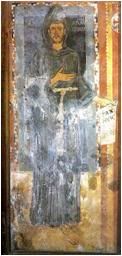
Augustine, Joachim, Bonaventure, Francis of Assisi.
"From then on, the attempt to dominate history in a theological sense was never again alien to Western theology..."(p. 15). At the start of the 13th century, this recurrent attempt to dominate history in terms of theology reached a new culminating point in Joachim of Fiore's prophecy of history" - and here is where the vision of the Italian 'modernist' and the German theologian coincide - "it reached...its maximum force only with the splendid confirmation given to it by the person and work of Francis of Assisi" (p. 16).
The two factors together - Joachim's call and the response of Franciscanism - placed into question the medieval image of history, generating a new, second culminating moment in the Christian way of thinking about history...represented by St. Bonaventure's Hexaemeron" (p.16)...
The intention of the Collationes was to 'counterpoint the spiritual disorientation of the time with the image of authentic Christian wisdom" (p.27), seriously settling accounts with the historical moment.
But - as Ratzinger is quick to take note - the six levels of knowledge, allegorically represented by the six days of creation and symbolized in the six eras of salvation, are further articulated into different levels which indisputably presented the growth in time of the levels of knowledge. Recognizing the historical character of Scriptural statements, Bonaventure differed from the interpretation of the Fathers and of scholastics who were guided by the idea of immutability. With the idea of theoriae arising from rationes seminales in a temporal perspective - 'a mirroring of future times in Scriptures" (P. 29) - Bonaventure adapted the interpretation of Scripture that Joachim had presented in his Concordia.
Bonaventure "thus affirmed that fundamental historic conception which was the decisive novelty brought by the Calabrian abbot (Joachim) to the thinking of the Fathers" (p. 29).
Scripture has certainly been fulfilled and Revelation is concluded, but its significance must continue to be searched continuously throughout history, and that search is not at an end" (cfr p. 29).
By our position in time, we see and understand more in some respects than the Fathers did. "In this way, the interpretation of Scriptures becomes a theology of history, an illumination of the past as prophecy for the future" (p. 30).
These were the premises that led Bonaventure to exclude Augustine from the theology of history, since he oriented everything to a correspondence between the story of the Old Testament and that of the New - an orientation which Augustine had resolutely rejected" (cfr p. 32).
In Bonaventure's theology, Christ is not the end of times - as in the Augustinian scheme - but the center of times, and it is this option that impels Bonaventure to believe in 'a new salvation that is realized 'in history', within the confines of earthly time" (p. 34). Then, even the Church in its realized form as "contemplative Church" is yet to come and we must still await its transformation in history (cfr p. 35).
Surprisingly, then, Ratzinger presents us with a Bonaventure who, in the summer of 1273, openly and consciously showed the influence of Joachim. But which Joachim?
Ratzinger quickly makes that clear: Bonaventure 'detaches himself clearly and resolutely' from the coarse manipulations that Gerardo di Borgo San Donnino had performed on Joachim, presenting the writings of the Calabrian abbot as an eternal Gospel designed to replace the transitory and perishable New Testament (cfr p. 45). But the rejection of Gerardo by Bonaventure cannot in any way be seen as a 'rejection of the original Joachim" (p. 46).
Thus, Ratzinger's reading fulfills two things at the same time: while he brings Bonaventure close to Joachim on the one hand, he separates Joachim clearly from the Joachimites, on the other hand.
I have said that Ratzinger's interpretation - which is in full and total rupture with preceding analyses by Martin Grabmann and Etienne Gilson, but along the lines of Alois Dempf and Leone Tondelli who paved the way for him, - brings Bonaventure close to Joachim.
But the young German theologian was also fully aware of the many differences between the Franciscan and the monk from Fiore.
The primary difference is in their evaluation of the times they lived in. Precisely because time and its passing are decisive in the visions of both Joachim and Bonaventure, the Franciscan could go beyond Joachim in reasoning, if only because 60 years separate the death of Joachim in 1202 from Bonaventure's Collationes in 1273.
The novelty introduced into medieval religion by Francis of Assisi
represents the great difference between the two. For Bonaventure - Francis's disciple, successor, and biographer - Francis was not a saint like others, but occupied an absolutely singular and preeminent place in the history of salvation, one who, in his conception, came to introduce the last phase of this history.
Francis, he wrote, was the new Elijah, the new John the Baptist, and, in Collationes, 'the angel who rises from the East' referred to in the Apocalypse (7,2), with the seal of the living God, namely the stigmata Francis received at Verna.
This image would run throughout the 13th century which Francis marked so much, and Bonaventure saw in Francis the figure announced by Joachim in the fourth book of Concordia who would be conferred 'the full liberty to renew the Christian religion".
To the Abbot of Fiore's prophecy, Francis's advent appeared like a prompt response, and it was Francis who would have the task of choosing the 144,000 elect who would found the chosen community at the end of times.
But in what measure does this novus ordo - mystic expression of the 'contemplative church' with which the sixth day of creation is transformed into the quiet Sabbath of the seventh day - correspond in empirical fact to the Franciscan order of which Bonaventure was the minister-general in that summer of 1273?
The question is fundamental, even for the consequences that it brings; and the analysis of texts conducted by Ratzinger is attentive to the nuances: It starts from Joachim, goes through the pseudo-Joachimite commentaries, to Jeremiah, and then dwells on the fundamental passages in Collatio XXI; before coming to the conclusion that Bonaventure, ignoring the pseudo-Joachims, takes off directly from Joachim, but actualizes him in the light of Francis and his movement.
If the fundamental thesis of the Spirituals was identification with the Franciscan order, or rather its spiritual branch as the order of the 'final times', Bonaventure rejects that equation and takes a different position: Francis had certainly inaugurated a new community of contemplative men but although it is intrinsically Franciscan, it could not be identified automatically with the actual Franciscan order. The order was perhaps originally destined to play such a role, but the the deviations of its members had brought the Franciscans, like the Dominicans, to the threshold of the 'new time' that they could prepare for, but without being able themselves to incarnate it personally.
And only when this new time arrived, only then would come the moment of full contemplatio and a renewed understanding of Scripture, the time of the Holy Spirit, and therefore, of introduction to the full truth of Jesus Christ.
In the eyes of Bonaventure, as analyzed by Ratzinger, Francis anticipated in his person the form of eschatological existence which, as a form of universal life, belongs to the future. One must conclude surprisingly that this realistic distinction between Francis and Franciscanism was "not only the discovery of liberal research on Francis" which had its most significant peak in the famous 1893 biography by Ernst Renan's pupil, Paul Sabatier, but had already been formulated by 'the great Franciscan superior-general of the 13th century" (p. 81).
This 'realistic distinction' is the key to understanding Bonaventure's behavior as minister-general and his attitude to life as a Franciscan: He could reject the sine glossa, the utter lack of compromise - that he recognized as Francis's desire - in both the exercise of his office, as well as his personal form of life, knowing that the hour had not yet struck. As long as the sixth day lasts, times would not be ripe for that radical Christian existence that Francis, by divine mission, could realize ahead of time in his own person.
Without any sense of unfaithfulness to the blessed founder of his order, Bonaventure could and had to, as a consequence, create for his order those institutional limits which he knew were never intended by Francis. [Bonaventure relaxed Francis's rules for the order.] It is too facile, and definitively wrong, to see this as a falsification of true Franciscanism....
Let us then return, in conclusion, to a passage in the preface of the American edition of this book, dated August 1969. In it, Ratzinger underscores how Collationes was the response to the profound crisis triggered in the Order and in the Church by the encounter between the Joachimite expectation and the Franciscan movement.
Bonaventure could have totally rejected Joachim, as Thomas Aquinas would later do, opting for a history that was all Augustinian and high Middle Ages, for the parable of a mundus senescens, an aging world, which is precipitating ineluctably towards a final crisis.
But doing so, he would have theologically rejected that novelty that Francis had brought, simply through his life, into the world: Bonaventure opts for a different path, which was risky but potentially very fecund: he interprets Joachim "within tradition, while the Joachimites interpreted him against tradition" (p. 12)
Doing so, the minister-general offered an ecclesial reading, which created an alternative to the radical Joachimites and at the same time sought to preserve the unity of the Order (cfr p.12).
Let us now take a step forward and remember that the author of the book we are presenting tonight became Pope on April 19, 2005, 46 years after his book came out, 36 years after he formulated the Preface for the American edition.
How can we not think, then, that the Pope, who addressed the Roman Curia on December 22, 2005, with his celebrated address on the legacy of the Second Vatican Council and on the need to read it as continuity in tradition and not as rupture, is not fulfilling - through that much disputed and discussed legacy of the Council - precisely the very operation that he identified in Bonaventure with respect to Joachim?
When Benedict XVI speaks of the 'right interpretation of the Council', its 'correct hermeneutic', the 'right key for its reading and application', is he not perhaps wishing for Vatican II the same reading that he was able to intuit in Bonaventure with respect to Joachim?
To interpret Vatican II 'within tradition', avoiding escapes and senseless defensiveness, is perhaps the profound key to this Pontificate. And it is quite fitting to think that a possible model for Benedict XVI could be seen in some way in the Bonaventurian theology of history as he portrayed it in his 1959 book and its reading of Joachim.
In this way, Prof. Ratzinger and Pope Benedict XVI reaffirm that theology, like Christian life, should remain in contact with its own history, without which it would be "a tree cut off from its own roots' (p. 12), condemned to dry up and wither.
We all know that the image of the tree was dear to Joachim, as it was to another 13th century interpreter, a faithful and original disciple of Bonaventure, Pietro di Giovanni Olivi - cited in a footnote of the 1959 book - who, in his comment on the Apocalypse, would present the history of the Church as a succession of statuses linked to each other by a concurrentia which unites them without a break, in such a way indeed that one generates the next.
It was Olivi, with the extraordinary parable of the man before the triple peak of a mountain, who expressed in the most effective way the new Joachimite-Bonaventurian conception of history.
We might add that it certainly does not seem by chance that the Prof. Ratzinger who dedicates the entire second chapter to the content of worldly hope in the new Joachimite-Bonaventurian sense would be the same person who in the 1980s and 1990s would face, as Prefect of the Congregation for the Doctrine of the Faith, the premises and consequences of liberation theology, and who as Pope, would dedicate his second encyclical to the subject of hope.
But we can well see that it is not only the content of the Bonaventurian operation that inspires Benedict XVI - that even its form does. In the final analysis, it is the model of a theologian called on to assume responsibility within the Church - the profile of the theologian Augustine who became Bishop of Hippo, in the 5th century; and in the 13th, that of the master teacher Bonaventure who became minister-general of the Franciscan order and cardinal - which perhaps lives again in the first Bishop of Rome in the 21st century, who was a theologian and remains one, drawing from his theological reflections the nourishment for his preaching and magisterium.
In this sense, reading this book from 1959 is not only illuminating for understanding Bonaventure and Franciscanism. It becomes invaluable for understanding the spirit of its author and perhaps, the profound spirit of his Pontificate.
====================================================================
BIOGRAPHICAL SKETCH OF ST. BONAVENTURE
ST. BONAVENTURE, OFM, Bishop and Doctor of the Church
Born in Bagnoregio near Viterbo, Italy, in 1221
Died at Lyons, France, in 1274
Canonized in 1482
Declared a Doctor of the Church in 1587 by Sixtus V
Known as 'the Seraphic Doctor'
Feast day July 14
Born Giovanni (John) di Fidanza, an untrustworthy legend says that his name was changed to Bonaventure ("good fortune") by Saint Francis of Assisi, who miraculously cured him of a dangerous illness during his childhood and exclaimed: O buona ventura!
A contemporary of Saint Thomas Aquinas and Saint Albert the Great, he went to the University of Paris when he was 14. There he studied theology under the English Franciscan, Alexander of Hales (the "Unanswerable Doctor"); and it was perhaps the influence of this teacher that induced him to enter the order when he was 20.
By 1248, he was a bachelor of Scripture; two years later he became a bachelor of theology; and three years after that he became a master of theology and was appointed to the professorial chair of the Friars Minor. He taught theology and Scripture, and preached in Paris for many years (1248-1255), concentrating on the elucidation of some of the problems that especially exercised men's minds in his day.
His teaching was curtailed by the opposition of secular professors, who were jealous of the new mendicants' success and were perhaps made uncomfortable by their austere lives when compared unfavorably with their own. Apparently, their disdain for the Franciscans, led the university to delay granting him a doctorate in theology, yet this did not embitter Bonaventure. With Aquinas he defended the mendicant friars against their opponents.
When the secular leader William of Saint-Armour wrote The perils of the last times, Bonaventure responded by publishing Concerning the poverty of Christ, a treatise on holy poverty. Pope Alexander IV denounced Saint-Armour, had his book burned, and ordered a halt to the attack on the mendicants. Thus, vindicated, the mendicant orders were re-established at Paris, and Bonaventure and Aquinas received their doctorates in theology in 1257.
That same year, when he was only 36, Bonaventure was elected minister general of the Franciscans. In this position he was faced with a difficult task, for though Saint Francis had established an incomparable spiritual ideal for his order, his organization was weak and since his death a number of different groups had arisen.
At the general chapter of Narbonne in 1260, Bonaventure designed a set of constitutions as a rule, which had a lasting effect on the order, and for which he is called the second founder of the Franciscans. It has, however, been claimed that he also weakened the spirit of Saint Francis; the Life that he wrote of him, in order to promote unity among the brothers, was accurate but incomplete, and he modified the rule that forbade the brothers to accept money or own property.
The strict-interpretation Spirituals among the Franciscans valued poverty above all else, including learning. Bonaventure strongly supported the importance of study to the order, and the need for the order to provide books and buildings. He confirmed the practice of monks teaching and studying at universities, believing that the Franciscans could better fulfill the need for preaching and spiritual guidance to compensate for other poorly educated clergy.
In addition to theological and philosophical works, Saint Bonaventure has left us sundry ascetical treatises, some of which have been translated into English including the Journey of the soul to God. The hymn In the Lord's atoning grief is a translation from Bonaventure.
Among his works are Commentary on the sentences of Peter Lombard (which covers the whole field of scholastic theology), the mystical works Breviloquium, Itinerarium mentis ad Deum, De reductione artium ad theologium, Perfection of life (written for Blessed Isabella, sister of Saint Louis IX, and her convent of Poor Clares), Soliloquy, The three-fold way, biblical commentaries, and sermons.
Bonaventure was nominated as archbishop of York in 1265, but refused the honor. In 1273, much against his will, Bonaventure was made cardinal and bishop of Albano by Pope Gregory X. His personal simplicity is illustrated by the story that when his cardinal's hat was brought to him at the friary in Mugello (near Florence), he told the legates to hang it on a nearby tree, as he was washing the dishes and his hands were wet and greasy.
 
At right is a photo of Zurbaran's 1629 painting of Aquinas and Bonaventure in Paris.
The following year, Pope Gregory called him to draw up the agenda for the 14th general council at Lyons to discuss the reunion of Rome with the churches of the East. Saint Thomas Aquinas died en route to the council. Bonaventure was the leading figure in the success of the council that effected the brief reunion, and led his last general chapter of the order between the third and fourth sessions. Bonaventure died while the Council of Lyons was still in session and was buried in Lyons.
Saint Bonaventure's reputation is based on his personal goodness and his skill as a theologian. "In him it seemed as though Adam had not sinned," wrote Alexander of Hales, and when he died the official record of the Council of Lyons stated: "In the morning died Brother Bonaventure of famous memory, a man outstanding in sanctity, kind, affable, pious and merciful, full of virtues, beloved of God and man. . . . God gave him the grace that whoever saw him conceived a great and heartfelt love for him."
The saint was known for his accessibility to any and all who wished to consult him, and once explained his urgency in making himself available to a simple lay brother by saying, "I am at the same time both prelate and master, and that poor brother is both my brother and my master."
Though Bonaventure and Aquinas were friends in their lifetime, the two men had strongly opposed each other on the question of the neo- Aristotelianism that was being introduced into theology, for Saint Bonaventure feared that as a result philosophy would be elevated above theology and that reason would be made more important than revelation.
Saint Bonaventure was a man of the highest intellectual attainments, but he would emphasize that a fool's love and knowledge of God may be greater than that of a humanly wise man. To reach God, he said, "little attention must be given to reason and great attention to grace, little to books and everything to the gift of God, which is the Holy Spirit."
Above all he emphasized charity: "For in truth, a poor and unlearned old woman can love God better than a Doctor of Theology."
Bonaventure believed that the created world gave us a sign of God. But faith was needed, honed by reason, to lead to contemplation of the divine. When his friend Aquinas asked where Bonaventure gained his own great knowledge, Bonaventure pointed to a crucifix. "I study only the crucified one, Jesus Christ," he replied.
Philosophy in itself was only an instrument, and unless it was modified in the light of revelation would lead into error, or into an arid preoccupation with intellectual arguments for their own sake.
In his opposition to Aristotelian philosophy, Saint Bonaventure no doubt went too far, and the synthesis achieved by Saint Thomas has had none of the disastrous effects that he feared.
Yet in taking his stand on the primacy of theology, he was aligning himself with the greatest of all Christian thinkers, Saint Augustine, and in stressing the supremacy of grace, he was following in the footsteps of the founder of his order, Saint Francis.
BIOGRAPHICAL NOTE ON JOACHIM OF FIORE:
Blessed Joachim of Fiore, OSB Cist. Abbot
(also known as Joachim de Floris)
Born at Celico, Calabria, Italy, c. 1130; died 1202.
Joachim was a visionary and prophet who, early in life, adopted an ascetic life. After a pilgrimage to Palestine, he entered the Cistercian abbey at Sambucina. In 1176, he became abbot of Corazzo, and about 1190, founded his own monastery at Fiore - a new Cistercian Congregation. His life was marked with great piety and simplicity.
He looked for a new age of the Spirit, when the papal Church would be superseded by a spiritual Church in which popes, priests, and ceremonies would disappear, and the Holy Spirit would fill the hearts of all Christ's followers.
Thus, his heart was Franciscan and, in a way, he anticipated the reforming zeal and simple faith of the Quakers. It is not surprising that doubts were sometimes thrown upon his orthodoxy and that many were disturbed by his original and even startling views.
Nevertheless, he opened the way for others to follow, and kindled a hope that ran through the medieval world and stirred the intellect of the Church. Reformation was in the air, and many things which he foresaw or foretold came to birth in the century that followed, in the great days of Dominic, Francis of Assisi, and Ignatius Loyola.
A new emphasis was placed on the work of the Holy Spirit, and after the gloom which preceded, there burst upon the world fresh and radiant visions of saintliness and virtue, and with them a new warmth and glow of religious life. A wave of exhilaration swept across Europe, and in that golden age of art and genius men looked beyond the outward forms and found in their own hearts a living and personal experience of God.
Joachim helped to give birth to this new mood of feeling and spontaneity, which later found song in such words as "O Jesus, King Most Wonderful" and "Jesu, the very thought of Thee." It was Pentecost set to music:
When once Thou visitest the heart,
Then truth begins to shine,
Then earthly vanities depart,
Then kindles love divine.
O Jesus, Light of all below!
Thou Fount of living fire,
Surpassing all the joys we know,
And all we can desire.
With this inner fire went a consuming love that burned in the heart of Saint Francis and his friars, that sent Dominic and his preachers out of their churches into the hills and highways, and that in a thousand monasteries set up Christian communities to care for the welfare of the people.
He was a prolific ascetical writer. His commentary on the Book of Revelation gave his the title "the Prophet" by which he was described by Dante: "the Calabrian abbot Joachim, endowed with prophetic spirit" (Paradiso, XII).
Thus Joachim was among the enthusiasts, who turned for inspiration to the Bible. Unfortunately, after his death the Franciscan Spirituals used his books to uphold their heretical tendencies. Nevertheless, Joachim has always been given the title of beatus, because, as a mystic and a prophet, he refreshed the life of the Church.
 |
| |
 03/09/2009 14:35 03/09/2009 14:35 |
|
| | | OFFLINE | | Post: 18.330
Post: 985 | Registrato il: 28/08/2005
Registrato il: 20/01/2009 | Administratore | Utente Senior | |
|
 www.diocesiviterbo.it/
Posted 9/1/09 in BENEDICT XVI NEWS:
GIFTS FOR THE POPE
www.diocesiviterbo.it/
Posted 9/1/09 in BENEDICT XVI NEWS:
GIFTS FOR THE POPE
 The new bronze doors
The new bronze doors
of St. Lawrence Cathedral
by Mons. Salvatore Del Ciuco

To give Viterbo an indelible record of the happy event of Pope Benedict XVI's visit to the City of Popes, Mons. Lorenzo Chiarinelli, Bishop of Viterbo, wanted his longtime project of new bronze doors for the Cathedral of St. Lawrence to be finally completed.
In 2005, he inaugurated the central door, shown below, called the Door of Light, executed by artist Roberto Joppolo.
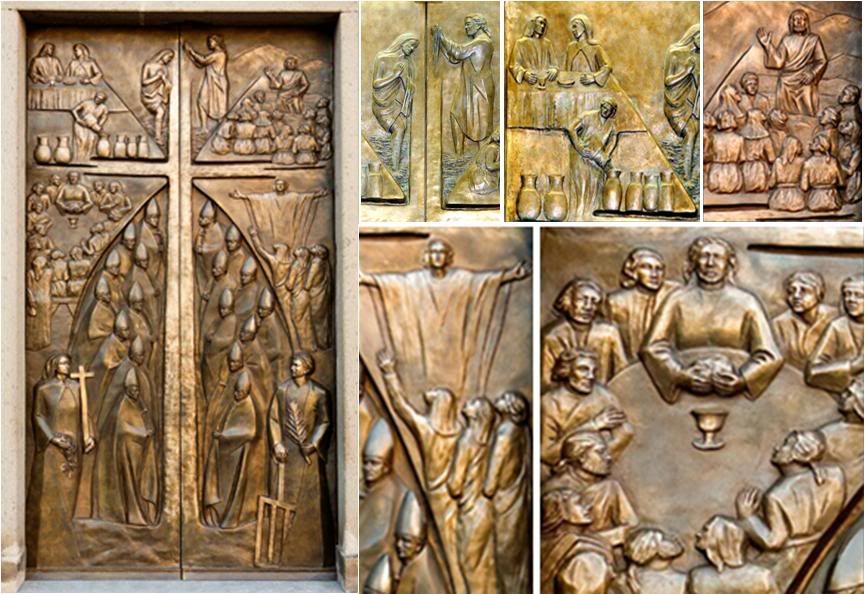
The door takes its name from the Luminous Mysteries of the Rosary, which are represented on the superior part of the door, 'radiating' from the central Cross and symbolizing the rays of light offered to the world by the Sacrifice of Christ - Christ is 'our Light and teh Light of the world".
Panels represent the Luminous Mysteries from the public life of Christ: The baptism of Jesus, the marriage at Cana, the Sermon on the Mount (announcement of the Kingdom), the Transfiguration of Jesus, and the institution of the Eucharist.
The lower part of the door features the two patron saints of Viterbo, St. Rose and St. Lawrence, depicted life-size on the left and right door panels. The central figures are the 12 cardinals who met in 1268 and had to be forced under lock and key - the first true 'Conclave' - to make up their minds and elect a Pope after three years of indecision.
New for Benedict XVI's visit are the side doors that complete Maestro Joppolo's triptych, and recount the historic reunification in 1986 of five dioceses into the Diocese of Viterbo, depicting the four co-cathedrals of the unified diocese, with the motto, 'Ex multis gentibus, unum corpus sumus' [Of many peoples, we are one body).
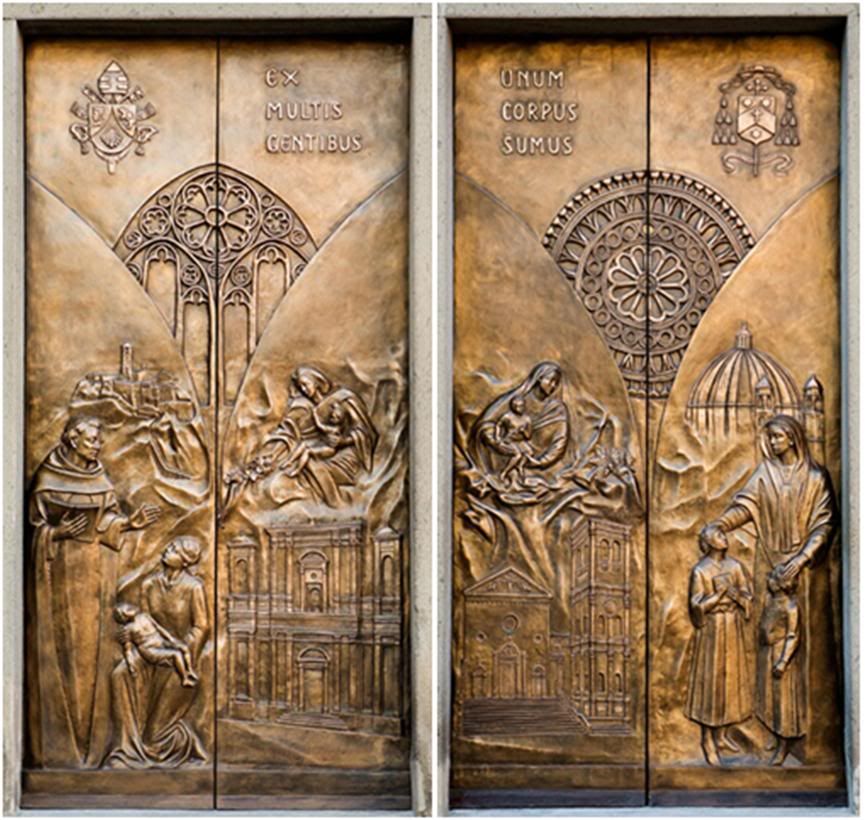
The left door carries on the upper left side the coat of arms of Pope Benedict; at bottom left is St. Bonaventure with his native town of Bagnoregio in the background, and on the right side, the facade of the Cathedral of the Holy Sepulchre in Acquapendente with the Madonna del Fiore. The center of the panel is a replica of a window from the co-cathedral of St. Martin in Cimino.
The right door has the coat of arms of Mons. Chiarinelli on the upper right corern; on the lower left side, the facade of the Shrine of the Madonna della Quercia and the image itself of the miraculous Virgin Mary who is the patron saint of the entire diocese; and on the right, the dome of Santa Margherita of Montefiascone and the latter city's patron saint Lucia di Filippini. In the center, the rose window from San Pietro in Tuscania.
Pope Benedict XVI will bless the new doors that symbolize the diocesan consolidation of 1986 and Mons. Chiarinelli's dream to leave Viterbo with a fitting artistic work and perennial reminder of the Pope's visit.
Viterbo's Cathedral Square, Piazza San Lorenzo. The fish eye view, top panel, shows the Cathedral in the center, and to its right, the complex of the Palace of the Popes. Bottom panel shows the Cathedral itself, and the Palace of the Popes with its famous Loggia. Pope Benedict will address the people of Viterbo from this vantage upon arriving in the city next Sunday.

 'Viterbo and the Popes':
'Viterbo and the Popes':
A book for Benedict XVI
Adapted and translated from

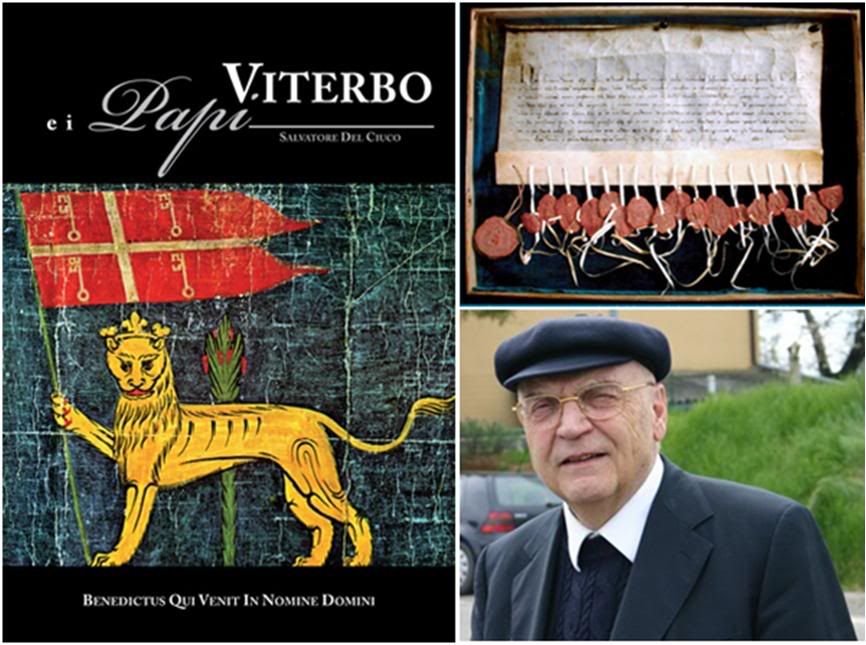 Upper right photo shows a note written by one of the cardinals locked in the first Conclave in 1286, requesting the citizens of Viterbo to help one of the cardinals who had fallen sick; lower right photo is Mons. Del Ciuco.
Upper right photo shows a note written by one of the cardinals locked in the first Conclave in 1286, requesting the citizens of Viterbo to help one of the cardinals who had fallen sick; lower right photo is Mons. Del Ciuco.
In fact, Mons Del Cuoco himself, the spokesman of the Diocese, has written 'Viterbo e i Papi' (Viterbo and the Popes), a book to mark Benedict's visit to Viterbo.
In presenting the book last month, Mons. Lorenzo Chiarinelli, Bishop of Viterbo said that Mons. Del Cuoco demonstrates his love for his native Viterbo whose distinctive characteristic is 'fulgens' (resplendent), his familiarity with the history of the city, particularly its centrality in Church affairs during the second half of the 13th century, when five Popes were elected and lived there, and his sincere admiration for the Viterban Popes and the living legacies they have left the city.
The book starts with Benedict XVI, however, and his visit to the city, the first by a Pope since the consolidation of 1986. At teh presentation, Mons. Chiarinelli said it will answer whether Joseph Ratzinger had ever visited Viterbo before. He called the book 'a splendid seal of a new century in our history".
The 150-page well-illustrated book is a joint project of the Diocese with the Banca di Viterbo.
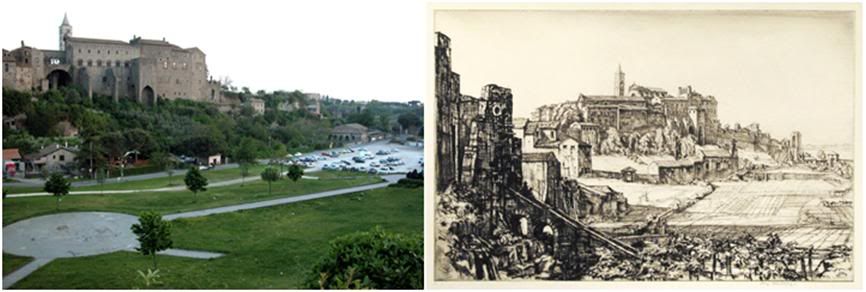 Right photo is one of the illustrations from the book, a 19th-century sketch showing a view of the Palace of the Popes from Valle Faul, the plain (left photo) where Pope Benedict will say Mass on Sept. 6.
Right photo is one of the illustrations from the book, a 19th-century sketch showing a view of the Palace of the Popes from Valle Faul, the plain (left photo) where Pope Benedict will say Mass on Sept. 6.
 From Bagnoregio to the Pope:
From Bagnoregio to the Pope:
A new sculpture of St. Bonaventure
Adapted and translated from


 Bottom panel shows two views of the new sculpture by the Paolucci brothers, and the statue of St. Bonaventure in Bagnoregio's Piazza San Agostino (how much more Ratzingerian can it be?) - from where Pope Benedict will be addressing the twonsfolk of Bagnoregio.
Bottom panel shows two views of the new sculpture by the Paolucci brothers, and the statue of St. Bonaventure in Bagnoregio's Piazza San Agostino (how much more Ratzingerian can it be?) - from where Pope Benedict will be addressing the twonsfolk of Bagnoregio.
In Bagnoregio, the municipality will give Benedict XVI a commissioned sculpture of St. Bonaventure which will be presented to the Holy Father bu Mayor Francesco Bigiotti on Sept. 6.
Bigiotti recalls that last year, the municipality had presented the Pope with a bas relief of St. Bonaventure, executed by the brothers Francesco and Gaetano Paolucci (whom he later commissioned to do the sculpture), at the time of a visit to the Vatican by a delegation from the Diocese of Viterbo.
It was then, Bigiotti said, that Mon. Chiarinelli first extended to the Pope an invitation to visit St. Bonaventure's birthplace.

|
| |
 03/09/2009 14:37 03/09/2009 14:37 |
|
| | | OFFLINE | | Post: 18.331
Post: 986 | Registrato il: 28/08/2005
Registrato il: 20/01/2009 | Administratore | Utente Senior | |
|
  Posted 9/3/09 in BENEDICT XVI NEWS:
Thanks to Scenron on Lella's blog
Posted 9/3/09 in BENEDICT XVI NEWS:
Thanks to Scenron on Lella's blog

for alerting us to this update from Brescia.
Bishop of Brescia announces
the program for Pope's visit
Translated from

Sept. 2, 2009
The bishop of Brescia, Mons. Luciano Monare, with the approval of the prefecture of the Pontifical Household, yesterday released the program for Pope Benedict XVI's visit to Brescia on Sunday, November 8.
Papa Ratzinger will be paying homage to Paul VI, a native of Brescia, who named him Archbishop of Munich-Freising and made him a cardinal.
The Pope will arrive in the morning at Ghedi military airbase on a special flight from Rome.
Enroute to Brescia from the airport, he will stop at the suburban parish church of Botticino Sera, to venerate the remains of St. Arcangelo Tadini, the sainted parish priest and champion of workers whom Benedict XVI canonized among five new saints last April 26.
In Brescia, the Pope will celebrate Mass and lead noontime Angelus prayers at the Piazza Paolo VI, after which he will lunch and have a brief rest at the Paul VI Center.
In the afternoon, he will go to Concesio, the suburb where Giovanni Battista Montini, the future Paul VI, was born. There, Benedict will inaugurate the new headquarters of the Istituto Paolo VI, a center for documentation, study and dissemination of his predecessor's life work.
Here is the program:
09.30 Ghedi - Arrival at the military airport of Ghedi
Papa Benedetto XVI giungerà all’aeroporto militare
Enroute to Brescia, the Pope will make a brief stopover at
the parish church of Botticino Sera to venerate the remains
of St. Arcangelo Tadini.
10.30 Brescia - Eucharistic Concelebration at the Piazza Paolo VI
- Angelus
13.00 Lunch and then a brief rest at the Paul VI Pastoral Center
16.45 Concesio
- Visit to the birthplace of Papa Montini
- Inauguration of the new headquarters of the Istituto Paolo VI
18.15 Visit to the parish church of Sant'Antonino
where Giovanni Battista Montini was baptized
19.00 Ghedi – Departure for Rome.
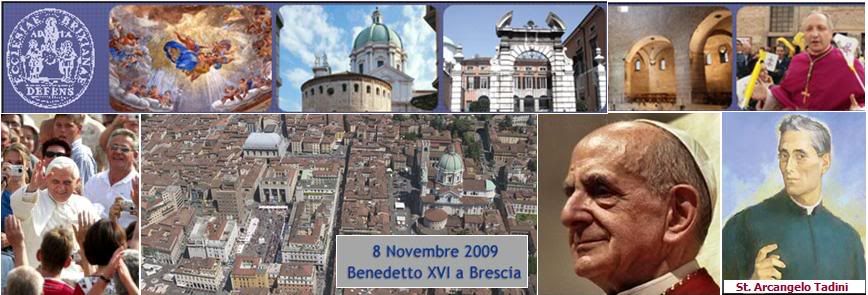
|
| |
 03/09/2009 14:38 03/09/2009 14:38 |
|
| | | OFFLINE | | Post: 18.332
Post: 987 | Registrato il: 28/08/2005
Registrato il: 20/01/2009 | Administratore | Utente Senior | |
|
 Posted earlier today in BENEDICT XVI NEWS:
Ratzinger's debt:
Posted earlier today in BENEDICT XVI NEWS:
Ratzinger's debt:
Benedict XVI comes to Bagnoregio
to honor one of his mentors in thought
by Saverio Gaeta
Translated from

Issue of 9/6/2009
The pastoral visit to Viterbo and Bagnoregio on Sunday, September 6, represents for Benedict XVI above all 'settling' a debt of gratitude with one of his intellectual mentors: St. Bonaventure, Bishop and Doctor of the Church.
He also thereby confirms the importance to the Church of the 'City of Popes' and its involvement in the history of the Papacy.
Benedict XVI first gave his informal consent to the this visit in January 2008 to Mons. Lorenzo Chiarinelli.

On that occasion, a delegation from the Diocese of Viterbo, along with local civilian authorities and officials of the Centro Studi Bonaventuriani had presented to the Pope the papers from a conference entitled "Faith in history: St. Bonaventure and Joseph Ratzinger".
They used the opportunity to invite the Pope to come to Viterbo and Bagnoregio. His response was immediate, "Of course. I have already been to Pavia" [where St. Augustine is buried].
The reference was explicit for anyone who knows the scholastic 'itinerary' of the budding theologian Joseph Ratzinger.
His doctoral thesis in 1953 was dedicated to The people and the house of God in St. Augustine's doctrine of the Church. Subsequently, one of his professors suggested that he study a medieval Catholic author for his thesis of Habilitation to qualify as a professor in German universities. Ratzinger chose St. Bonaventure of Bagnoregio.
"The resulting text was published in 1959, under the title The theology of history in St. Bonaventure'", continues Mons, Chiarinelli, "and it represented a new interpretation of the Doctor Seraphicus, especially his concept of revelation, understood as the way in which God communicates himself to man, and what his vision of history owe to Joachim of Fiore.
Prof. Ratzinger overturned the prevailing hypothesis that Bonaventure had completely condemned Joachim's thought, and showed instead how much he tried to accommodate what could be integrated into the tradition of the Church.
Monsignor Chiarinelli, how would you describe the relations of the Popes with this diocese?
I think some figures will tell the story: Fifty Popes have visited the city, 18 have lived here for more then 6 months, five were elected here, and four are buried here.
And of course, one cannot forget that the first true 'conclave' in history took place in Viterbo, after the infamous story of 33 months of 'sede vacante' [without a Pope] in 1268-1271, after which Gregory X was finally elected.
Research has now shown that it was St. Bonaventure who suggested to the 'people's captain' Raniero Gatti the closure under lock and key [cum clave'] of the 17 cardinals who could not come to an agreement.
What is the 'snapshot' of the diocese that Benedict XVI will see?
He will see a composite ecclesial entity, in which the various components are gradually settling into effective interaction. With the reform decided by John Paul II in March 1986, Viterbo absorbed four ancient dioceses and an abbey.
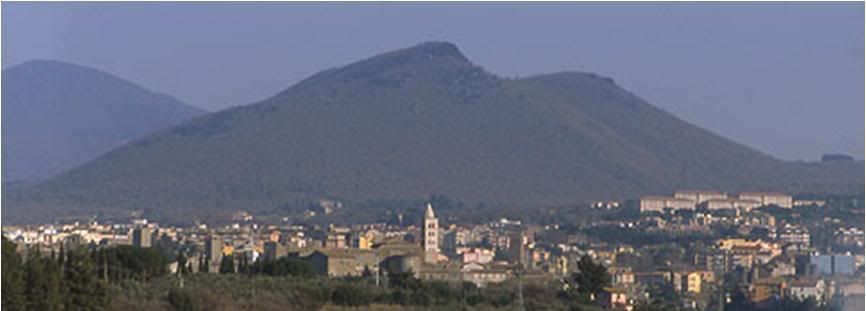

 Top photo, Viterbo panorama. Center panel, from left, clockwise: Acquapendente, Bagnoregio, Tuscania and Montefiascone. Bottom photo, the Cistercian Abbey of San Nichele in Cimino.
Top photo, Viterbo panorama. Center panel, from left, clockwise: Acquapendente, Bagnoregio, Tuscania and Montefiascone. Bottom photo, the Cistercian Abbey of San Nichele in Cimino.
Each of these components has a specific cultural and religious background: Viterbo has a natural tendency towards Rome; Acquapendente has a Tuscan sensibility; Bagnoregio is very much linked to Umbria; Tuscania has a Maremman context [the Maremma is the area of west central Italy adjoining the Tyrrhenian Sea]; Montefiascone is some sort of island in High Tuscia [Tuscia is the historical-geographical area in the region of Lazio that was the ancient homeland of Italy's pre-Roman Etruscan culture]; and then, there is the Abbey of San Martino in Cimino with its own rich history.
Viterbo also has a rich spiritual tradition that is dense with exceptional saints and highly popular devotions...
The principal spiritual reference is the Madonna della Quercia (Our Lady of the Oak), who is venerated as the patron of the diocese in her own shrine, where Papa Ratzinger will meet privately with the cloistered nuns from 12 monasteries.
Then we have the emblematic figure of Santa Rosa, a model of charity and firmness in the faith, to whom is dedicated the famous annual procession with the so-called 'Macchina di Santa Rosa' [a towering float elaborately designed and lit to carry the image of the saint].
We have other exemplary women models: St. Lucia Filippini, who founded the Maestre Pie [Pious teachers] religious congregation; St. Rosa Venerini, who started the first girls' schools; Blessed Gabriella Sagheddu, who was named by John Paul II as the patron of spiritual ecumenism.
Then we have the Capuchin St. Crispin and the Passionist Blessed Domenico Barberi, who was the one who welcomed John Henry Newman into the Catholic Church in Birmingham.
What do you expect to come out of the Pope's visit to this land?
The principal outcome is expressed in the motto we have given to the visit: 'Confirm your brothers'. It is also the pastoral theme that has guided us in the diocese, since faith itself is the true challenge for the Church in contemporary society.
In this respect, we are trying to actively involve the youth - we have 10,000 students in Viterbo attending the University of Tuscia - who run the grave risk of a religious-cultural rupture with preceding generations.
Finally, a new impetus for charity, in a diocese that already has 62 volunteer associations and numerous institutions for hospitality and solidarity with the needy.
THE DIOCESE OF VITERBO:
- 2,161 square kilometers
- 172,839 residents
- 97 parishes
- 168 priests
- 8 deacons
 The theological lesson from
The theological lesson from
St. Bonaventure's 'little old woman'
Translated from

September 2, 2009
On Sunday, Benedict XVI will be in Bagnoregio, birthplace of St. Bonaventure, one of his intellectual references.
As a young priest, Joseph Ratzinger obtained his habilitation to be a professor in Germany with a study on the theology of history of the Franciscan saint and Doctor of the Church who made clear, much more than anyone before him, the idea that Christ is the center and axis of human history.
There is much of Bonaventure in Papa Ratzinger. Above all, the awareness that reason alone does not suffice. Both Bonaventure and Benedict insist on trusting rationality and the goodness of theological science, but are also equally convinced that without a a relationship of love with God, reason and knowledge are incomplete.
"A little old woman could love God much more than a master of theology," Bonaventure observed.
At an audience last year, the Pope underscored this central aspect of Bonaventure's theology: "Love sees more than reason. Where there is the light of love, then the shadows of reason have no access. Love sees, love is an eye, and experience gives us more than reflection. Love makes the difference".
On Sunday, Benedict XVI will kneel before a relic of the saint. It is almost like a response to the muggy media polemics in August, which centered on the easy abortion pill and an official decision to relegate religious instruction to a a free-time option in Italy's public schools.
If these represent what secular scientific rationality today has achieved, then Italy needs a gust of fresh air. May St. Bonaventure help us open ourselves to wider perspectives.
|
| |
 05/09/2009 06:51 05/09/2009 06:51 |
|
| | | OFFLINE | | Post: 18.342
Post: 996 | Registrato il: 28/08/2005
Registrato il: 20/01/2009 | Administratore | Utente Senior | |
|
 SANTA ROSA:
SANTA ROSA:
Viterbo's prodigious patron
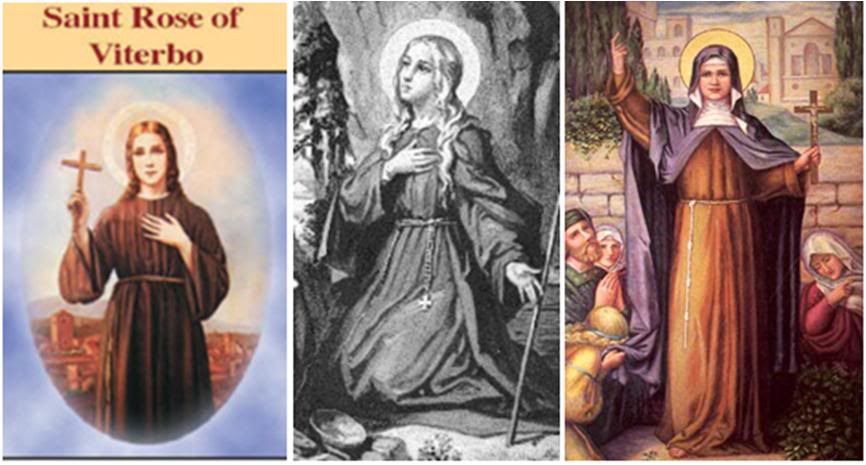
It was the feast day Friday (Sept. 4) of Viterbo's patron saint, Santa Rosa, one of the great saints the Italian Church produced in the 13th century. Her story is almost a continuing miracle.
She was born of poor and pious parents, in the spring of 1235, after a long time when they thought they were barren. At this time, the Holy Roman Emperor Frederick II was oppressing the Church and many Catholics turned their loyalties to him.
Frederick at first had seemed faithful to his duty to protect the Holy See, but eventually he became blinded by ambition. His goal was to restore the “Roman empire over the world.” Rome would be the capital of the world, and Frederick would be the real emperor of the Romans.
To accomplish this, Frederick published an energetic manifesto denouncing the “world empire” of the Papacy. It was but one more example of those who would destroy true Authority in the name of “reform.”
Pope Gregory IX excommunicated the “self-confessed heretic,” the “blasphemous beast of the Apocalypse” (March 20, 1239). Frederick then attempted to conquer the rest of Italy, i.e. the Papal States. His son Henry captured in a naval battle all of the Prelates who by the command of His Holiness Pope Gregory were coming from Genoa to Rome to assist at a General Council.
After Gregory's death (August 22, 1241), the Holy See remained vacant for almost two years save for the short reign of Pope Celestine IV.
The infant Rose seemed filled with grace from her birth; her first words were Jesus and Mary; with tottering steps she sought Jesus in His tabernacle, she knelt before sacred images, she listened to pious conversation, retaining all she heard.
When but three years old, she raised to life her maternal aunt. Her body had lain an entire day in the coffin, and towards night she was to be buried. Rose, in the presence of her parents and other friends, approached the dead woman, and, touching the dismal bier, called her aunt with a loud voice. The dead woman opened her eyes, returned to health and strength, and lived for many years.
The account of this very rare miracle is to be read in the process containing the proofs of Rosa's sanctity; it is also illustrated by ancient paintings in her church, which time has now nearly effaced. The fame of this miracle spread rapidly, and so efficacious did it
prove, that the people were moved to devotion, and rose up against the imperialists, glorifying God's greatness and the holy Faith.
Another favorite story from Rosa's childhood is that one day, as she
was occupied in some holy meditation, she heard the voices of some poor people who were begging in the street.
She ran to fetch some pieces of bread she had reserved for this purpose, and went to give them to the beggars, carrying the bread in her apron. She met her father at the door, who had already previously forbidden her from such 'charities' because they themselves lived hand to mouth.
He angrily asked her to open her apron. The child obeyed, and unfolding her apron, in the place of bread, her lap was filled with the choicest and sweetest roses. Her father learned from this that He who could turn bread into roses, could also provide for this family's needs even if they helped the less fortunate by sharing their food and clothing.
At the age of seven, Rose was already living the life of a recluse who mortified herself with penances and fasting. She wore only a coarse habit and walked around barefoot.
Pope Innocent IV ascended the Papal Throne on June 15, 1243. Frederick offered some concessions, but it was clear that he was bent on having the Papal States. The Pope secretly left Rome, arrived at Lyons on December 2, 1244, and early in 1245 summoned the Bishops and princes to a Council there.
The First Council of Lyons opened on June 28, but waited for the absent Frederick for three weeks. When he still failed to arrive, the Council passed sentence of excommunication, and the Pope declared Frederick deposed of his imperial authority. This caused great turmoil in Germany, as the clergy generally supported the Pope, but the nobility generally supported Frederick (thus helping to set the stage for the Protestant revolution centuries later). Meanwhile in Italy, Frederick continued to gain control over Papal territory.
Viterbo, too, fell to the imperial power (the Ghibellines); but here, in a sickly little girl, the mighty Frederic would find one of his greatest foes.
Her health succumbed, but she was miraculously cured by the Blessed Virgin, who ordered her to enroll herself in the Third Order of St. Francis, and to preach penance to Viterbo, at that time (1247) held by Frederick II of Germany and a prey to political strife and heresy.
Hardly twelve years old, Rose went down to the public square at Viterbo, called upon the inhabitants to be faithful to the Sovereign Pontiff, and vehemently denounced all his opponents.
So great was the power of her word, and of the miracles - she healed the sick and restored sight to the blind - which accompanied it, that the Ghibellines, in fear and anger, drove her from the city in January, 1250.
Rosa and her parents took refuge in Soriano. On December 5, 1250, Rosa foretold the speedy death of the emperor, a prophecy realized on December 13.
Soon afterwards she went to Vitorchiano, whose inhabitants had been perverted by a famous sorceress. Rosa secured the conversion of all, even of the sorceress, by standing unscathed for three hours in the flames of a burning pyre, a miracle as striking as it is well attested.
Pope Innocent IV was brought back in triumph to Rome and the cause of God was won. With the restoration of the papal power in Viterbo (1251) Rosa returned. She wished to enter the monastery of St. Mary of the Roses, but was refused because she had no dowry to offer. She humbly submitted, foretelling her admission to the monastery after her death.
The remainder of her life was spent in the cell in her father's house, where she died in her eighteenth year.
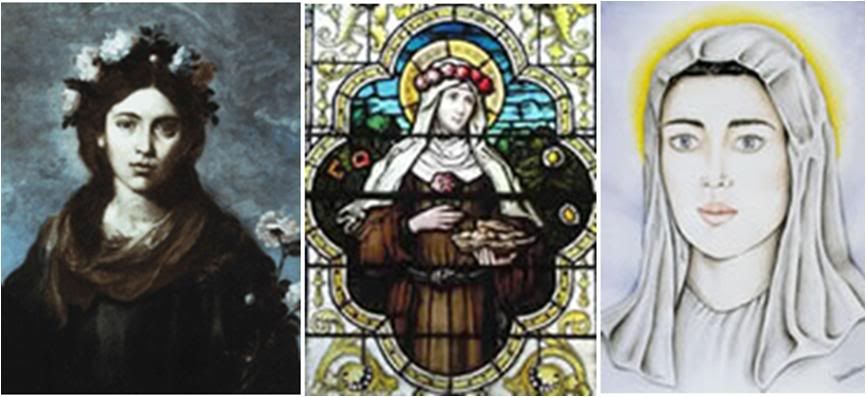
Not long after, she appeared in glory to Pope Alexander IV, and bade him translate her body. from its unmarked grave where her family had buried her in secrecy to keep the faithful from trying to get relics of her. It is said the Pope himself started digging and found the body as the vision had said, but fragrant and beautiful, as if still in life. And though it was autumn, there was a rose bush with a single red rose on the spot.
The incorrupt body was transferred to the Church of St. Mary of the Roses as she had predicted she would be accepted after her death.
Her feast is celebrated on Sept. 4th, the date her body was translated.
[A recent visitor to Viterbo says that the saint's body is now dark and wizened, reportedly the effect of a fire.]
In any case, Santa Rosa's feast is celebrated in a unique way in Viterbo:
THE MACCHINA OF SANTA ROSA
Adapted from a blog entry on 8/24/09
by an Englishman who now lives in Italy.
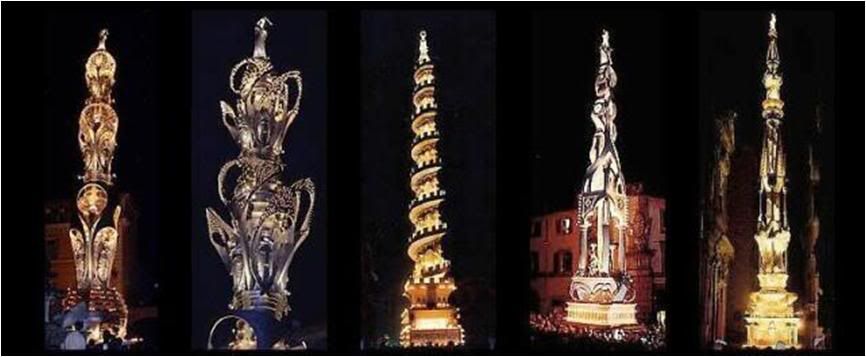
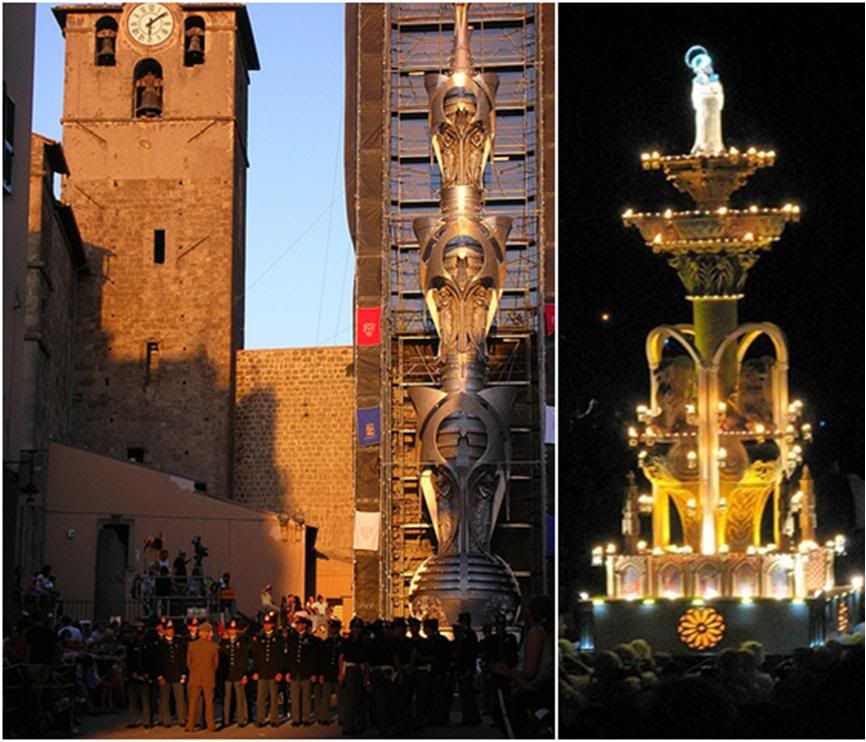
On the 3rd of September, eve of the feast of Santa Rosa, the people of Viterbo start their annual homage to their patron saint. It is the day of 'La macchina' - a massive 28-metre high tower, weighing over 5 metric tonnes, illuminated with 3000 tiny electric lights and 880 candles, and topped off with a statue of the saint.
It is carried for 1200 metres through the darkened streets of the old medieval town on the backs of 1300 volunteers called “facchini.”
The tradition goes all the way back to 4th September 1258 when the body of the saint was exhumed by Pope Alexander IV after a series of dreams which led him to her unmarked tomb.
Found to be extremely well preserved, the body was transported to the monastery of Saint Damian. With a few exceptions the procession has been repeated each year since; but it wasn’t until 1664, following seven years of plague in the city, that the “macchina” first appeared.
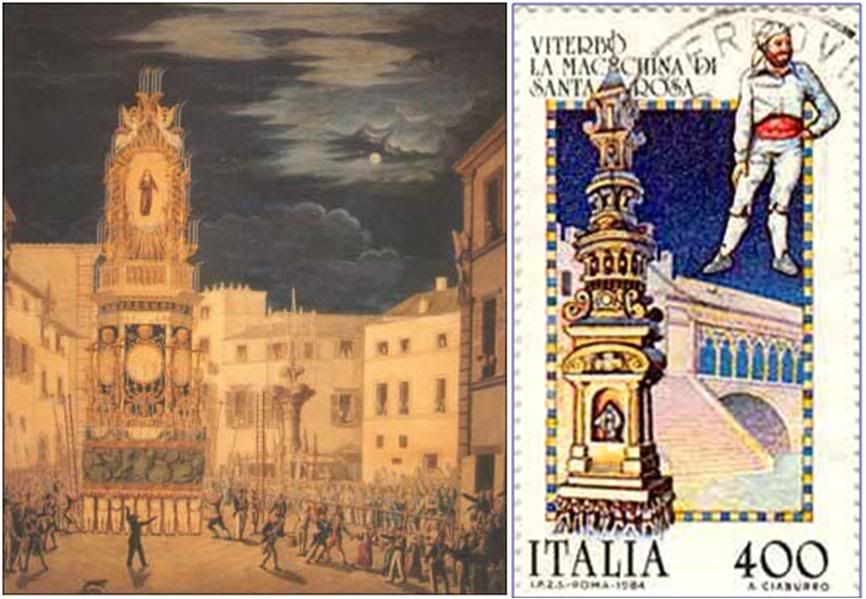
In gratitude for having survived such a terrible pestilence the citizens voted to renew the veneration of their saint with a float that would be bigger and and more beautiful every year.
Successive floats have reflected architectural influences and tastes of the times with Baroque and Rococo, Byzantine, Gothic and even Arabic style constructions, and grown ever taller with each new version, eventually reaching the tops of the houses.
 Left, 2003-2008 Macchina; center, the 2009 Macchina.
Left, 2003-2008 Macchina; center, the 2009 Macchina.
The Macchina built in 2003 towered a good two storeys above the houses and even pokes above the churches along the route. Nowadays a new Macchina is built every five years but cannot exceed the height and weight limit of 28 metres and 5,000 kilos.
The “facchini” are selected in June. Selection depends on being able to carry 150kgs over 80 metres. Most of the facchini are veterans from many years, and ages range from 20 to over 60. The present longest serving veteran is Guido Politini with 44 years experience. Typically about 10-15 new facchini are recruited every year.
At midday on the 3rd September the town is already buzzing in anticipation. Residents of the town centrre have reserved their places by leaving chairs at the end of sideroads and alleyways leading onto the machine’s route.
At 3 pm the facchini, dressed all in white, including white bandanas on their heads, and red sashes round their waists, gather to march in procession through the town. Crowds are already gathered to applaud them as they march in ranks, shouting “Vivi i facchini” and the facchini replying with “Viva Santa Rosa!” Another chant is "E' viva Santa Rosa?" (Does Saint Rose live still?) to which the facchini reply "E' viva!" (She lives!)
Led by the town band, who will be playing their hearts out to the same tune for about the next nine hours, and accompanied by the mayor and local dignitaries they stop off at the cathedral and six other churches along the way to render prayers and songs to Saint Rose.
After all this marching the facchini take a break to eat in the grounds of a local monastery, along with their families who bring along plenty of home made pasta dishes and bottles of wine. Fortified they get their final instructions from the chief (capo facchino) who rouses them with an eve of Agincourt type speech.
The procession of the Macchina starts at 9pm. At about a quarter to nine the facchini enter the church of Saint Sisto to receive the last rites from the bishop of Viterbo, A reminder of the real danger that the task ahead holds.
In fact past processions have not been without incident, the most tragic in 1801 when 22 spectators died in the panic caused when some of the crowd mistakenly thought the machine was toppling over. Sometimes it really has: in 1814 killing two facchini. No serious incidents have occured in modern times.
With leather pouches on their heads or shoulders to spare their vertebrae and shoulder bones, they lift the towering ensemble and march off in step down hill, still preceeded by the town’s band, to the first of five resting points.
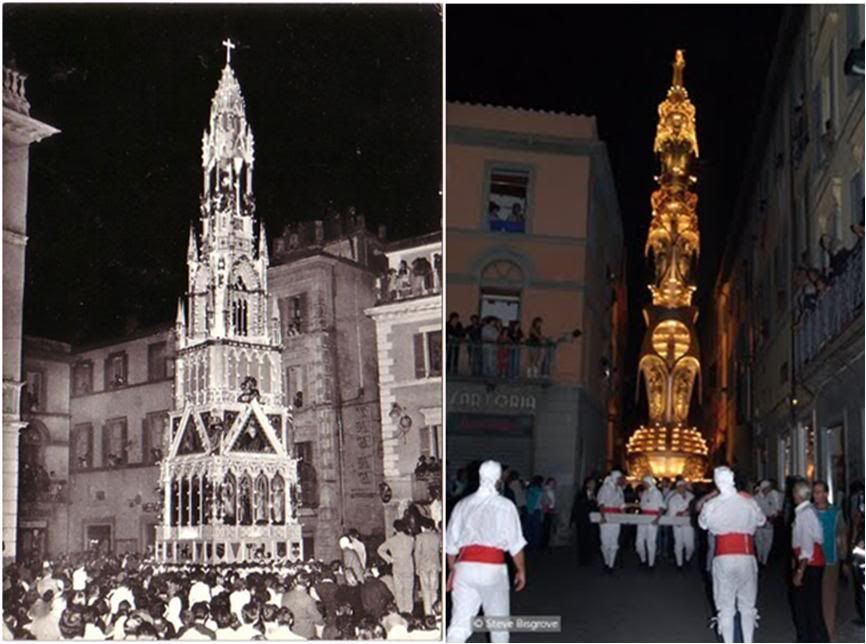
Three thousand eight hundred and eighty points of light flicker and dance as the machine wobbles on its way, the crowd are in ecstasy, cheering and screaming encouragement at the facchini.
Facchini rush to take their places under the Macchina. These are the ciuffi, there are 63 of them and they carry the weight on both shoulders and wear padded leather headgear called a ciuffo. Others bear the weight on just one shoulder.
At the first stop in the piazza of the town hall other facchini rush to place giant trestles on which the facchini underneath gently bring the behemoth to rest. Its a tricky and dangerous operation and emotions are running high.
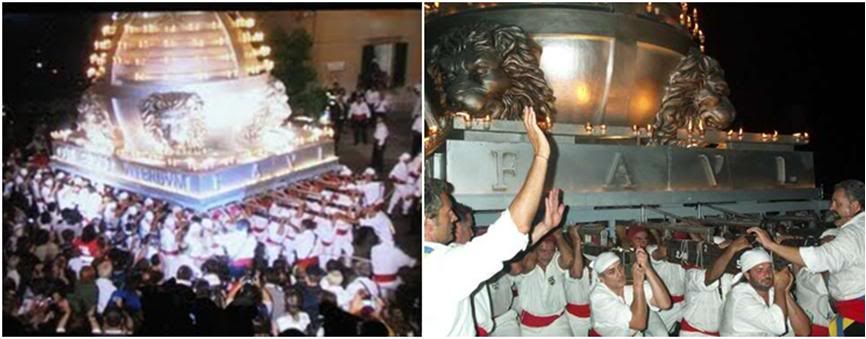
A ten minute breather and the machine is taken up again. This time there are only about 90 facchini lifting it, as the street narrows considerably at this point, but we’re also going uphill here. With a lack of pavements on the street people crowd balconies and windows, shop doorways, sideroads and all over any handy fountain.
Everything is pitch dark, until, towering over the houses, the machine hoves into view, a rocking, throbbing pillar of light illuminating everything on either side before passing on. The crowd fall in behind as if drawn by a magnet.
Slowly the machine makes its way through the streets. An hour or so later, after three more stops, it emerges into Piazza Verdi where the biggest crowds are. The facchini turn it around 360 degrees to to line it up ready for the last and most demanding leg. The end is in sight. The final destination is in front of the Church of Santa Rosa, where the body of the saint now rests.
The road to the church is only around 180 metres long, but rises considerably. To tackle this part extra facchini join in to help, making 149 all told, twenty pulling on ropes and others on levers at the back, the tallest to the rear and shortest to the front in order to keep everything as level as possible.
After the capo facchino deems all is ready, the order is given, and they take it at at a trot. They reach their goal in a muscle bursting minute. Once the glittering tower is finally resting on its trestles the tension and the strain leaves the faces of the facchini: they have done it again this year. Now tears of joy and relief take over as they celebrate and hug each other and their families.
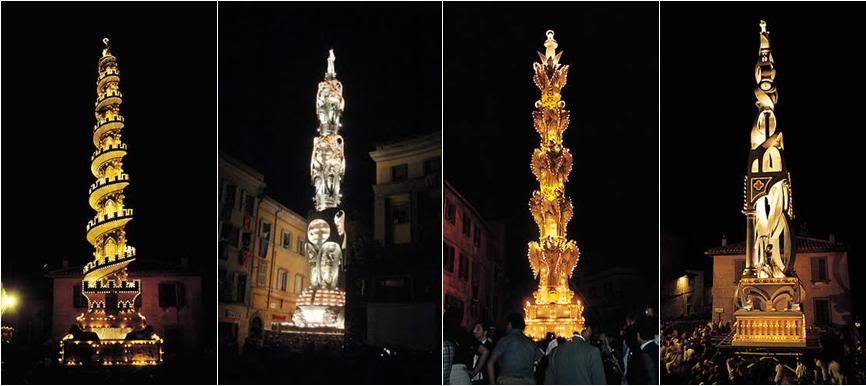
The city shares in their triumph. The machine will now remain on display for several days in front of the church while several thousand devotees visit and pay homage to their saint.
Pope Benedict XVI is expected to see the Macchina, a new one this year, when he comes to Viterbo on Sunday.
[Modificato da TERESA BENEDETTA 05/09/2009 07:01] |
| |
|
|
|
|